Posts Tagged ‘Logging’
Thursday, January 23rd, 2014
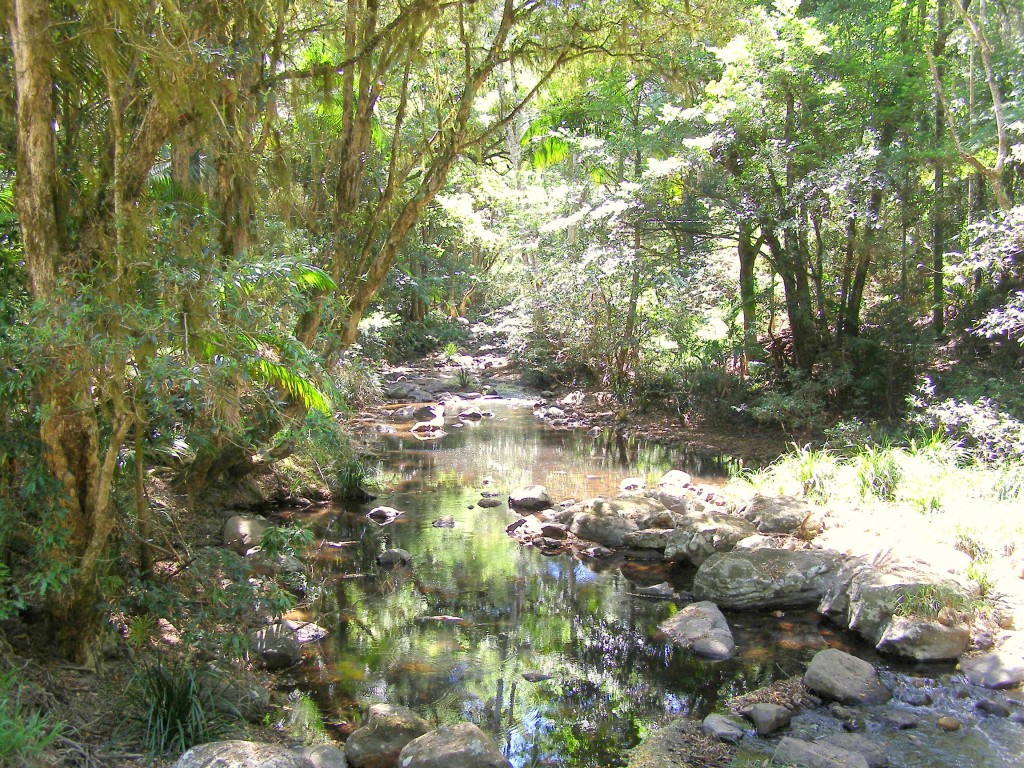 Terania Creek
Toward Nightcap National Park, part of the Gondwana Rainforests of Australia World Heritage Area,
Northern Rivers Region, New South Wales, Australia.
‘Terania‘ is thought to be a local Aboriginal (Bundjalung) name meaning ‘place of frogs’.
[Click image to enlarge, photo by Editor 20131023, © under ^Creative Commons] Terania Creek
Toward Nightcap National Park, part of the Gondwana Rainforests of Australia World Heritage Area,
Northern Rivers Region, New South Wales, Australia.
‘Terania‘ is thought to be a local Aboriginal (Bundjalung) name meaning ‘place of frogs’.
[Click image to enlarge, photo by Editor 20131023, © under ^Creative Commons]
.
Today’s National Parks and Wildlife Service website on Nightcap National Park reads as follows:
.
<<Nightcap National Park, part of the Gondwana Rainforests of Australia World Heritage Area, is a dramatically beautiful park full of ancient rainforests, magical waterways and spectacular views. The lush rainforest provides a home for the newly discovered nightcap oak as well as a number of threatened animal species, including Albert’s lyrebird and Fleay’s barred frog which takes shelter under leaf litter and makes an ‘ok-okok-ok-ok’ after rain.
With easy access from Lismore and Nimbin, you can enjoy a picnic, bushwalk or overnight camping trip amid the park’s escarpments, waterfalls and crystal clear creeks and enjoy incredible views of the 20 million year-old Wollumbin shield volcano. >>
[Source: National Parks and Wildlife Service, NSW Government, ^http://www.nationalparks.nsw.gov.au/nightcap-national-park]
.
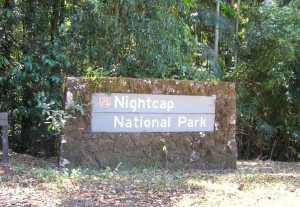
.
However, were it not for a handful of dedicated environmental activists protesting on site in the late 1970s, the Nightcap National Park would not exist.
Its magnificent rainforest ecology would be have been decimated by industrial logging, then scorched-earthed and the entire landscape converted to pasture, resembling much of what has occurred throughout the Northern Rivers Region.
In the late 1970s, the government sent in the police to protect the loggers, not the rainforest.
<< Terania Creek, located in the Nightcap Range in northern New South Wales was the site of the first major forest blockade in Australian history. Over 200 protesters halted logging of the rainforest, through non-violent direct action. In 1982, a similar protest occurred at Mount Nadi on the other side of the Nightcap Range. In 1982, the Premier, Neville Wran, declared a moratorium on the logging of rainforests in New South Wales. Today, the Nightcap National Park incorporates Mount Nadi, Griers Scrub and Terania Creek. >>
[Source: ‘Australian environmental activism Timeline’, Board of Studies NSW, New South Wales Government, ^http://www.teachingheritage.nsw.edu.au/section03/timeenviron.php]
.
So when one visits the National Parks offices staffed by government employees, reflect on the fact that the offices and staff exist not because of government leadership, but because of the selfless will of environmental activists prepared to go to jail to save these invaluable and increasingly rare rainforests.
.
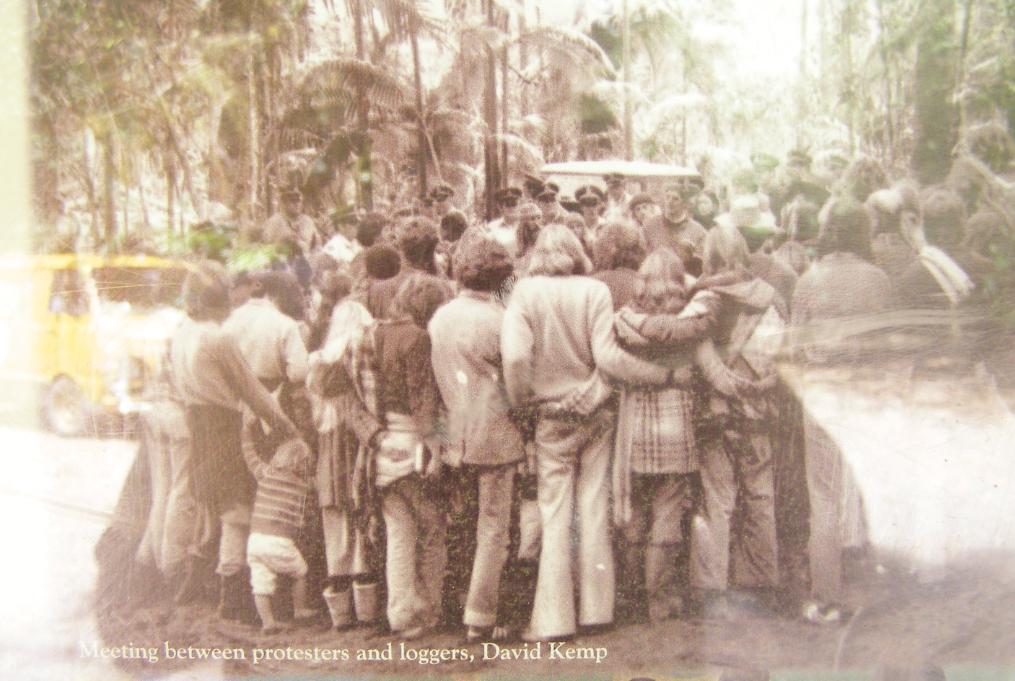 Community direct action protest against logging at Terania Creek in 1979
This black and white photo by David Kemp (1979) is part of a faded pictorial history montage behind glass in a National Parks visitor noticeboard located at Protesters Falls car park, alongside Terania Creek. The image of the original photo has fault in that it includes reflection from the glass showing a yellow van at the car park, not in 1979 but in 2013. We happily walked along the board walk to Protesters Falls, passing by we assume the van’s owner happily bent backwards meditating on a large beach ball within the shaded tranquillity of the very tall rainforest. Unawares, he has inspired the writing of this article.
[Click image to enlarge, photo by Editor 20131023, © under ^Creative Commons] Community direct action protest against logging at Terania Creek in 1979
This black and white photo by David Kemp (1979) is part of a faded pictorial history montage behind glass in a National Parks visitor noticeboard located at Protesters Falls car park, alongside Terania Creek. The image of the original photo has fault in that it includes reflection from the glass showing a yellow van at the car park, not in 1979 but in 2013. We happily walked along the board walk to Protesters Falls, passing by we assume the van’s owner happily bent backwards meditating on a large beach ball within the shaded tranquillity of the very tall rainforest. Unawares, he has inspired the writing of this article.
[Click image to enlarge, photo by Editor 20131023, © under ^Creative Commons]
.
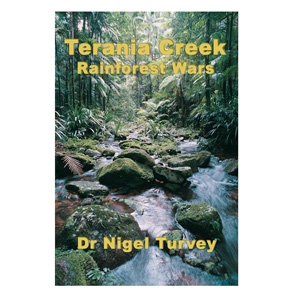 Find Out More: ^http://nigelturvey.com/page1001.aspx Find Out More: ^http://nigelturvey.com/page1001.aspx
.
<< The conflict began in 1979 over a small patch of rainforest in Terania Creek, in north-eastern New South Wales. It was Australia’s first forest protest, and it was ahead of its time both globally and environmentally. The conflict spread across New South Wales and pushed forestry issues to the forefront of politics. Protesters from Terania Creek went on to similar conflicts in the Franklin River in Tasmania, the Daintree rainforests in Queensland, and Errinundra Plateau in Victoria.
Inevitably, people on both sides of the conflict suffered. Protesters were vilified as hippies and dole bludgers, and their lifestyles and homes were targeted. Workers in the forest and sawmills were labelled as loggers and vandals, and their families and businesses were damaged. >>
.
[Quoted extract from the preface in the non-fiction book, ‘Terania Creek: Rainforest Wars‘, (2006) by author Dr Nigel Turvey, published by Glass House Books, Brisbane. A part of what has now become Australian history that needed to be told, a reflective generation later].
.
The power of ‘Direct Action’ to turn government and public opinion
.
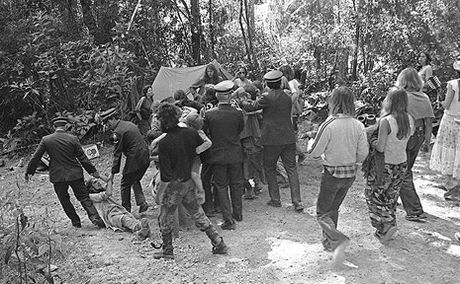 Local resident Neil Pike (left) being dragged away from the protest site by police down Mackay’s Road 17th August 1979
[© Photo by Darcy McFadden, The Northern Star (newspaper) photographer]. Local resident Neil Pike (left) being dragged away from the protest site by police down Mackay’s Road 17th August 1979
[© Photo by Darcy McFadden, The Northern Star (newspaper) photographer].
.
Nearby Mt Nardi resident and musician Neil Pike:
<< “Some time during 1975 there were signs up around Nimbin about the logging plans for Terania Creek. By 1979, when the loggers were due to arrive in the valley, a lot of discussion was going on at The Channon Markets.”
.
Channon Markets Sunday, August 12, 1979:
“There was a big rally and the protest organisers asked if they could use my PA. They called for people to blockade and a lot of people went straight from the market to the Nicholson property which bordered the rainforest. We camped there for more than a month. Everyone was up at the bulldozer, blocking its way into the rainforest – there were cops everywhere.
“A cop told one of the protest organisers to get everyone to move down the track but I stayed where I was as most people moved off. That’s when the two cops grabbed me and dragged me down the track to the paddy wagon – it was at least a few minutes and they fractured two of my vertebrae.”
The blockade was the catalyst for the NSW Government to gazette the remaining rainforest in the state, including Terania Creek, as National Park. >>
.
[Source: ‘Direct action saved Terania’, article by Georgina Bible, 20090815, The Northern Star newspaper, Norther Rivers Region, ^http://www.northernstar.com.au/news/direct-action-saved-terania/296606/]
.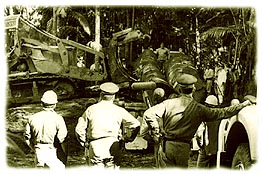
.
One of Australia’s most fiercely fought environmental battles
.
<< “Urban refugees Hugh and Nan Nicholson moved onto a property at Terania Creek in northern NSW 30 years ago. They were hoping to escape the rat race and live a self-sufficient lifestyle, but discovered that the forest surrounding their property was earmarked for extensive logging.
So began one of Australia’s most fiercely fought environmental battles, the 1979-1982 Rainforest Wars. The wars ended with the formation of Nightcap National Park, which was World Heritage-listed for good measure in 1989.
Author Nigel Turvey, a former forester and environmental scientist, stands (respectfully) on the shoulders of those who were there, using their words and pictures to give us an insightful overview of an emotionally charged environmental campaign from beginning to end; he even sets it firmly in its time with references to other newsworthy happenings such as the Azaria Chamberlain case and the Vietnam War.
One of the unexpected bonuses of this book is that it offers an inside look at the forestry profession and how it fell from grace (in the public’s eyes) during this campaign, never to recover again.
‘Terania Creek: Rainforest Wars‘ is a real page-turner and a must-read for anyone interested in conflicts in Australia’s natural places.” >>
.
[Source: Review by Louise Southerden, ^http://www.greenlifestylemag.com.au/reviews/516/terania-creek-rainforest-wars]
.
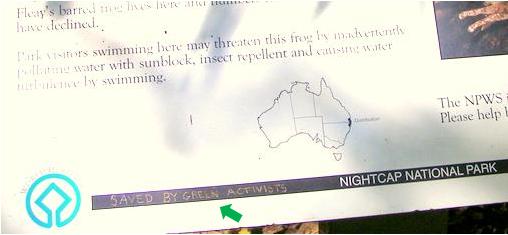 The National Parks Sign with appropriate graffiti-etched message.
A poignant reminder that Nightcap National Park came about only because of Community Direct Action.
[Photo by Editor 20131023 in Nightcap NationalPark, © under ^Creative Commons] The National Parks Sign with appropriate graffiti-etched message.
A poignant reminder that Nightcap National Park came about only because of Community Direct Action.
[Photo by Editor 20131023 in Nightcap NationalPark, © under ^Creative Commons]
.
‘Terania Creek: Rainforest Wars’ – extracts from Chapter 1
.
[Ed: This book is a must read for any environmentalist/conservationist with a respect for the pioneers of environmental direct action and for any student of the Conservation Movement]
.
<< On the easternmost part of Australia, it survived the drifting continent’s climatic shifts and a hundred and fifty years of timber-getting. In 1979 some claimed it was the last unlogged rainforest and should be saved, but for foresters and saw-millers it was the last rainforest they would plan to log. The dispute over logging flared into the Rainforest War across New South Wales.
Today forest protests are part of Australia’s political landscape, but Terania Creek was the first.
This story is about the people from both sides who fought over the rainforest, but the enduring player in the story is the rainforest itself.
Enter the forest and you find mottled tree trunks soaring to crowns high in the canopy, supported by elegantly curved or plank-like buttresses, taller than a man, smaller trees with no buttresses at all, and trees with tumbling bifurcating trunks that grow downwards to the ground, encircling and strangling the small trees that give them support. You crouch to avoid the tangle of creepers as thick as a forearm, and the vines, some armed with hooks, which loop between the trees.>>
.
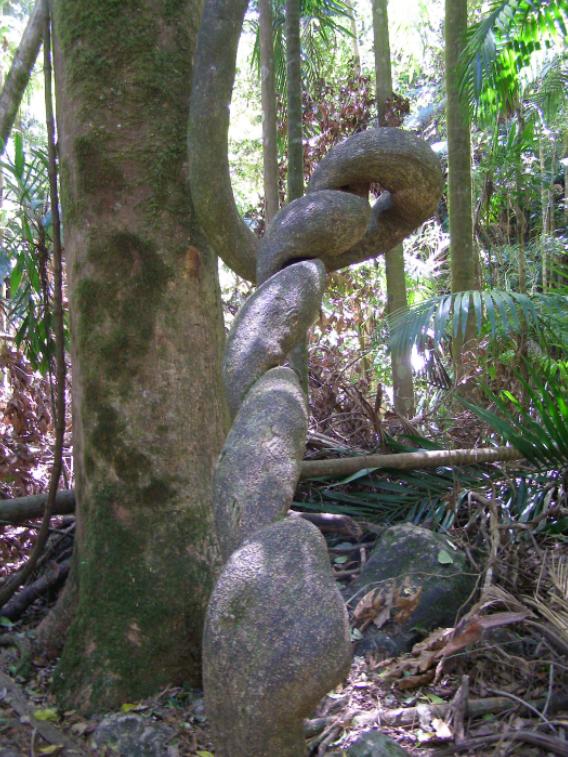 “tangle of creepers as thick as a forearm”
[Photo by Editor 20131023 in Nightcap National Park, © under ^Creative Commons] “tangle of creepers as thick as a forearm”
[Photo by Editor 20131023 in Nightcap National Park, © under ^Creative Commons]
.
<< You stand under tree ferns several metres tall, with their fragile fronds and insubstantial stems protected by the high humidity and dense shade under the forest’s multiple canopy layers. And in a quiet moment you hear the startling stereophonic calls of a whip-bird and its mate. >>
.
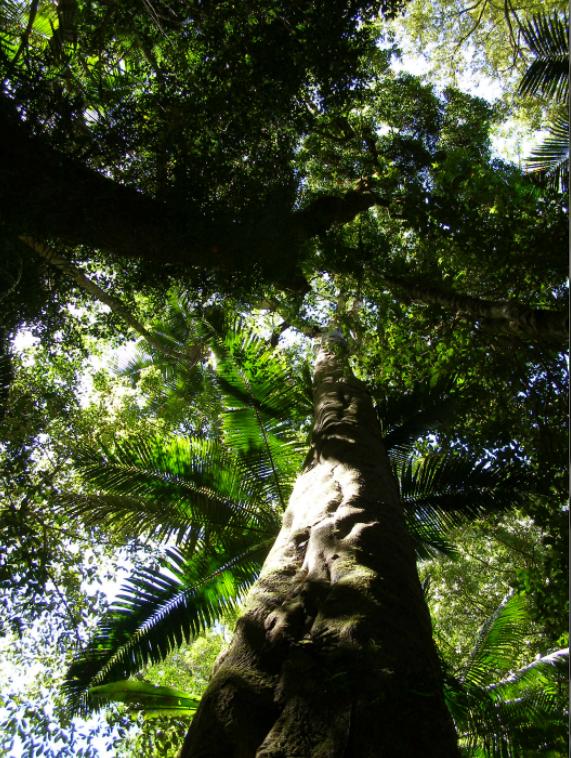 Yellow carabeen (Sloanea woollsii)
growing to 55 metres and vital to the rainforest canopy
[Photo by Editor 20131023 in Nightcap National Park, © under ^Creative Commons] Yellow carabeen (Sloanea woollsii)
growing to 55 metres and vital to the rainforest canopy
[Photo by Editor 20131023 in Nightcap National Park, © under ^Creative Commons]
.
<< In the early part of the twentieth century, the rainforests and drier eucalypt forests of the caldera (volcanic basin) were logged by sawmills that grew up around the ranges, providing timber for new rural industries and housing for the expanding population of the young State of New South Wales.
Soft workable timbers were harvested from remote rainforest refuges, like Terania Creek, in uncontrolled logging to supply the war effort during World War II. Bush crews returned to log the southern part of Terania Creek in the 1950s and again in 1968, but the northern part of the basin under the overhanging cliffs remained untouched. >>
.
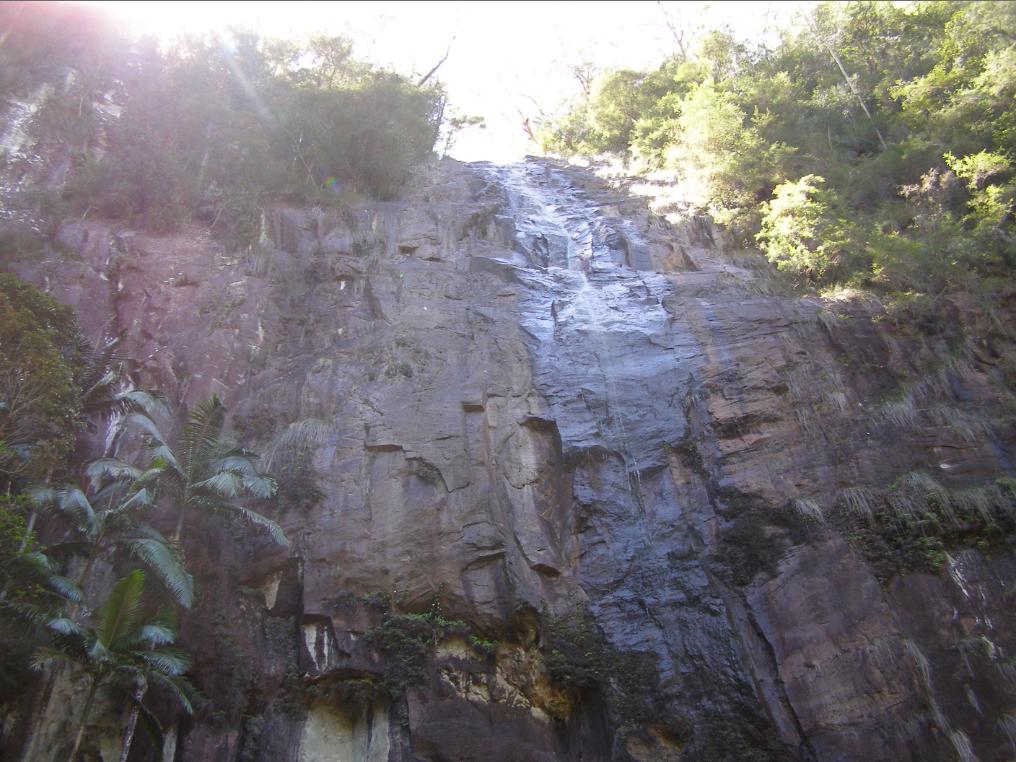 Protesters Falls, Terania Creek
The overhanging cliffs so described by Dr Turvey, appropriately since named in honour of those who protested and saved the rainforest from logging
[Photo by Editor 20131023 in Nightcap National Park, © under ^Creative Commons] Protesters Falls, Terania Creek
The overhanging cliffs so described by Dr Turvey, appropriately since named in honour of those who protested and saved the rainforest from logging
[Photo by Editor 20131023 in Nightcap National Park, © under ^Creative Commons]
.
<< More than two hundred years of European activity along the eastern seaboard reduced Australia’s rainforests by three quarters of their pre-1770 cover, through clearing for agriculture, uncontrolled logging, and conversion to plantations (and dairy pasture). The rainforests, which covered just 1% of Australia two hundred years ago, now cover just one quarter of one percent of the Australian landmass.
The dairy industry that had flourished on the cleared slopes of the caldera was in decline by the 1970s, and young settlers moved on to the cheap farmland. >>
.
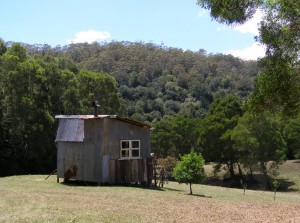 [Photo by Editor 20131026, © under ^Creative Commons] [Photo by Editor 20131026, © under ^Creative Commons]
.
<< In September 1973 Hugh and Nan Nicholson, two urban refugees looking for a self-sufficient lifestyle, found Terania Creek. They drove north from the hamlet of The Channon on a rough dirt road through steepening hills that forced the road to wind tightly around and through the creek on the valley floor.
.
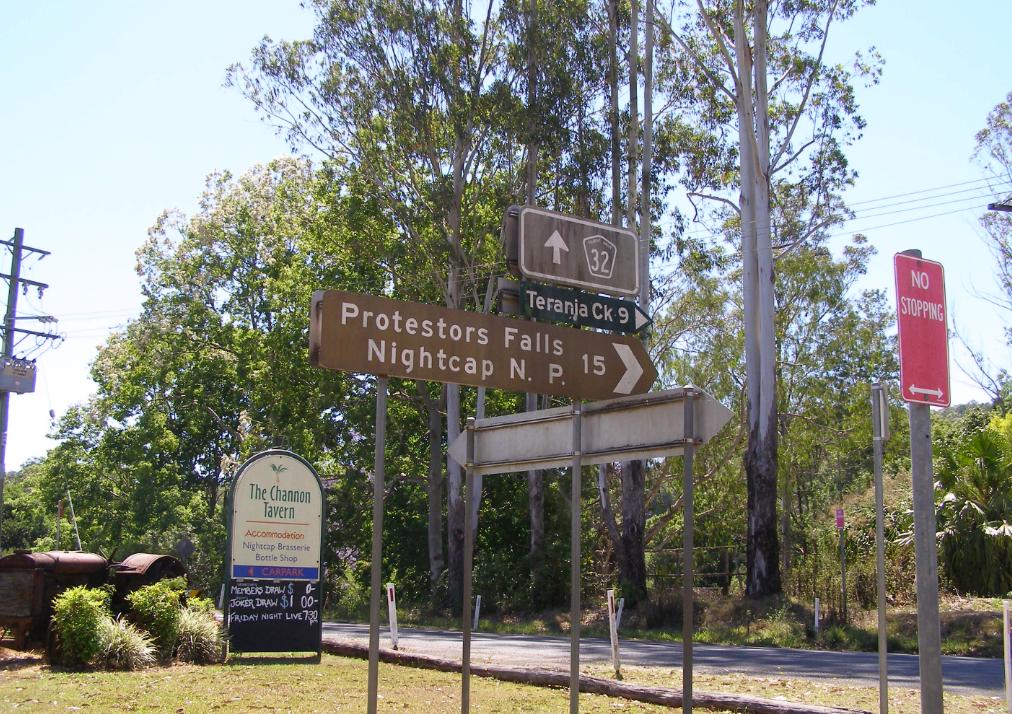 The Channon (hamlet), turnoff to Terania Creek
[Click image to enlarge, photo by Editor 20131023] The Channon (hamlet), turnoff to Terania Creek
[Click image to enlarge, photo by Editor 20131023]
.
<< Just before the valley sides closed in completely they found a small patch of cleared land running a short distance upslope from the creek flats. It was the last cleared land at the end of the road, a degraded dairy farm losing ground to encroaching weeds (typically Lantana). On the eastern boundary, across the creek, was the rainforest of Whian Whian State Forest, and on the northern boundary was Goonimbar State Forest with its tall, moist rainforest and palm communities. The forests were held in the basin of Terania Creek, ringed with cliffs below the backdrop of the Nightcap Range. >>
.
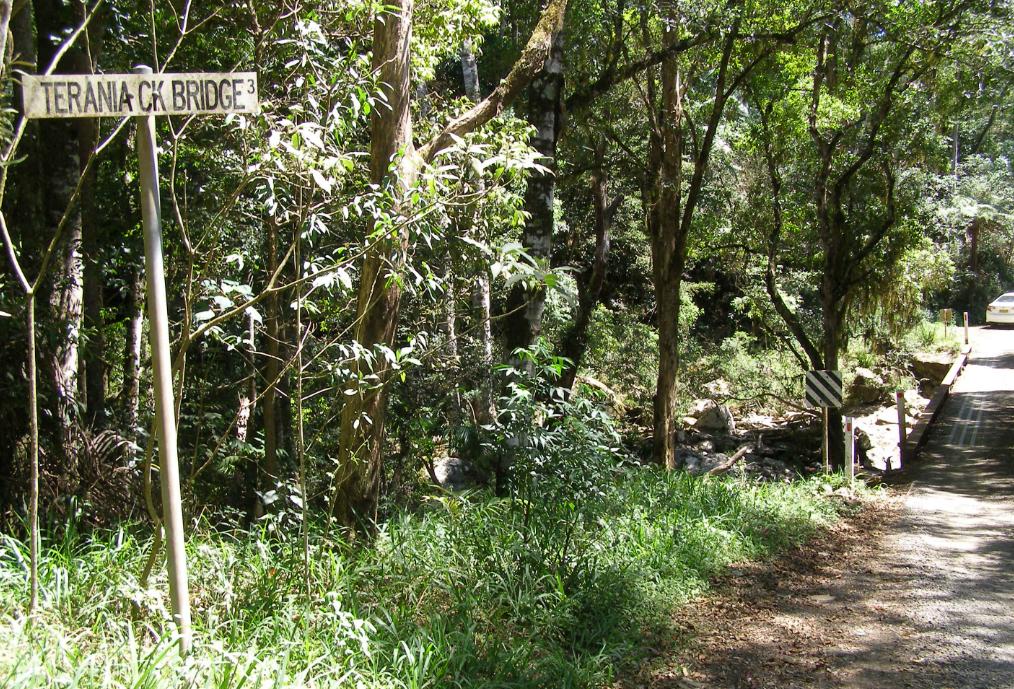 The road following up and crossing over Terania Creek multiple times.
Photo by Editor 20131023, © under ^Creative Commons] The road following up and crossing over Terania Creek multiple times.
Photo by Editor 20131023, © under ^Creative Commons]
.
<< It fitted all their criteria: it was a scene of exceptional beauty, an inspirational landscape, a spiritual refuge.>>
.
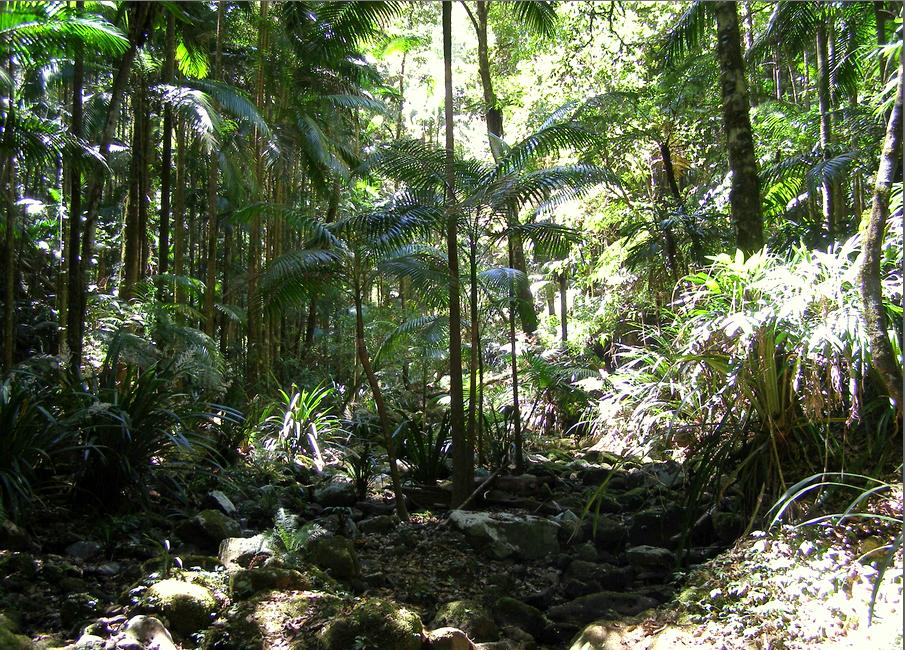 Terania Creek now protected inside the Nightcap National Park
[Photo by Editor 20131023, © under ^Creative Commons] Terania Creek now protected inside the Nightcap National Park
[Photo by Editor 20131023, © under ^Creative Commons]
.
<<Then a war broke out in this most peaceful landscape – the Rainforest War. It started in 1979 with a battle over the rainforests of Terania Creek and spread to rainforests across the State of New South Wales. On one side were the young settlers making their homes around the caldera. On the other side were the Forestry Commission of New South Wales and the sawmills it licensed.
The new settlers were bent on protecting the forests; they felt a spiritual relationship with the rainforests, were in awe on the ancient life-forms and felt duty-bound to protect them. The Forestry Commission, in contrast, managed extensive forest regions on long cycles of cutting and regeneration according to silvicultural principles of forest management. Geographically, its focus was regional and broad, whereas that of the protesters, initially was local and narrow; its intervention was based on science (agroforestry) and economics while that of the protesters was based on conservation (ecological science which then not been formalised) and spirituality.>>
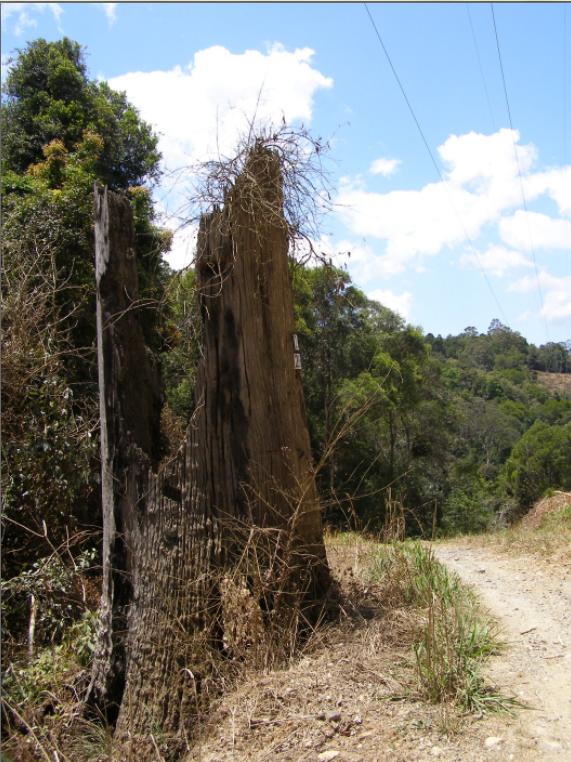 Lest We Forget
What could have been at Terania Creek, and what is left of much of Gondwana in Australia
[Photo by Editor 20131026, © under ^Creative Commons] Lest We Forget
What could have been at Terania Creek, and what is left of much of Gondwana in Australia
[Photo by Editor 20131026, © under ^Creative Commons]
.
<< The events that followed make up the story of The Rainforest War…But the central character of the story is the rainforest of Terania Creek, claimed by protesters as the last unlogged rainforest. Its ancient genetic lineage of buttressed trunks, soft leaves, colourful flowers and fleshy fruits appeared vulnerable and stimulated a primitive instinct in those who entered it. Like a newborn infant, the marvel of its existence inspired its own protection. It is a spiritual landscape – the living archaeology of Gondwana. >>
.
[Source: ‘Terania Creek: Rainforest Wars‘, (2006) by author Dr Nigel Turvey, published by Glass House Books, Brisbane, ^http://nigelturvey.com/page1001.aspx]
.
The joys of trouble-making on a grand scale!
.
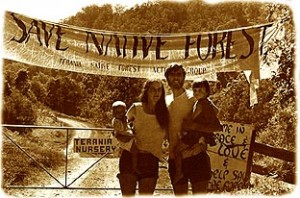 . .
<< Helicopters landed in the paddocks, police cars parked all over our precious grass, the campers kept expanding their area. All along Hugh and I had feared defeat and the loss of that exquisite forest. Now we feared loss of control of our lives. And we weren’t even getting into the forest to do the heroic stuff with all the other activists. We were pinned to the cabin with the phone stuck on an ear, sitting in strategy meetings while trying to remember where the kids were, or hunting for vital but constantly disappearing papers.
But we loved it too. The joys of trouble-making on a grand scale! The media whirlwind! The politicians suddenly ringing us! The euphoria of watching so many different skills miraculously dovetailing for an inspired purpose! The discovery of so many fascinating and resourceful people!
And on top of all that, after four weeks of intensity, we won. It was hard to believe. Was it the daily road blocks or the protestors up trees that did it? Was it the cut-up logs? That was bad press and everyone was appalled but it stopped the trees being felled wholesale. Was it brilliant, or just lucky, media manipulation? Was it the penetrating and relentless phone calls by Bren Claridge to Premier Wran’s office? Was it the lack of trespass laws which would have kept us out of the forest? Was it simply a state government leaving all the pawns to fight it out and point to the safe jumping side? Was the time just right to save rainforest or did we help to make the time happen?
Community cohesion thrives on tackling big issues together. And there are huge challenges confronting us: the local impact of climate change; the Dunoon Dam; the inevitable attack on forests thought saved for ever; an increasing regional population that also expects more per person in resources; the breath-taking irrationality of the belief that growth without limits is even possible let alone desirable.
People still come up to us in the street and say “I was at Terania Creek and it changed the direction of my life!” It sounds so corny now but it did feel like a coming-of-age for all of us, the new-age interlopers, even if it wasn’t appreciated by the “real” locals. Our ideal of self-sufficient living had turned out to be insufficient until it had acknowledged and defended the landscape in which it was embedded.
Finally, if nothing else, the wrestle for Terania Creek finally put us in touch with the original custodians, the people who fought for the land first and were massacred for it, in one of the worst killing fields in the entire country. We realised that fighting for your own backyard is a long-standing and deeply honourable activity. If everyone genuinely safeguarded their own patch most environmental problems would evaporate. And so would many social problems, since it is connectedness with its people and its history which enables little communities like ours to love themselves.
I don’t know but I would do it all again. In fact, as a community we need to do it all again. >>
.
[Source: ‘Saving Terania: Nan Nicholson’s personal perspective on the Terania blockade’, Terania EnviroAction Network, ^http://rainbowregion.com.au/environment/index.php?option=com_content&view=article&id=73:saving-terania&catid=41:my-word&Itemid=98]
.
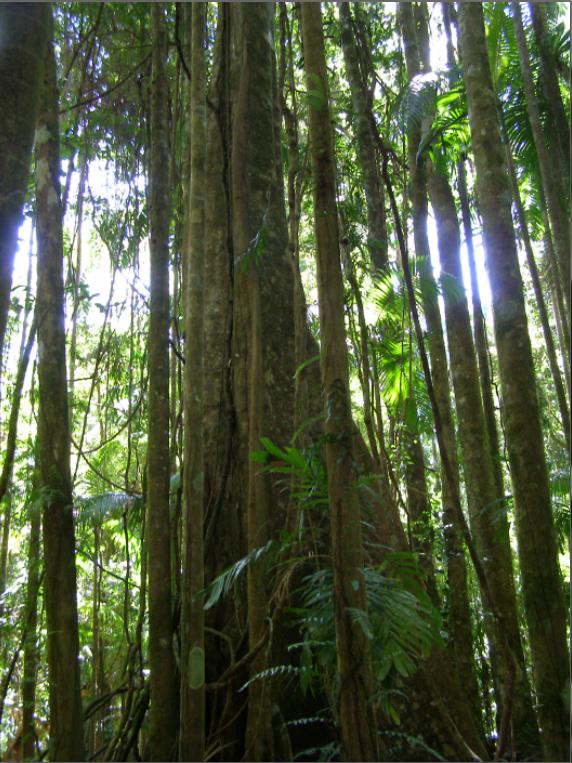 [Photo by Editor 20131023 in Nightcap National Park, © under ^Creative Commons] [Photo by Editor 20131023 in Nightcap National Park, © under ^Creative Commons]
.
Further Reading
.
[1] ‘Terania Creek: Rainforest Wars‘, (2006) by author Dr Nigel Turvey, published by Glass House Books, Brisbane, ^http://nigelturvey.com/page1001.aspx]
.
[2] ‘Saving Terania: Nan Nicholson’s personal perspective on the Terania Blockade‘, Terania EnviroAction Network, ^http://rainbowregion.com.au/environment/index.php?option=com_content&view=article&id=73:saving-terania&catid=41:my-word&Itemid=98]
.
[3] ‘Terania Creek Diary‘, ^http://www.rainforestinfo.org.au/terania/diary.htm
.
[4] ‘May The Circle Be Unbroken‘, by Dudley Leggett, Terania Creek Action, 1979, ^http://www.rainforestinfo.org.au/terania/circle.htm
.
<< “The protest against the logging in Terania Creek Basin has been an occurrence of great social significance and for those present a spiritual experience unprecedented in their lifetime.
The spirit of caring and sharing that ebbed and flowed throughout the four week long camp of resistance was the strongest evidence that any had encountered of what was repeatedly described as tribalism but which might more easily be described as brotherhood. Perhaps it was the nature of the trees and their timeless passive servitude to man which evoked the deep inner feelings of a holy cause in their protection. Or was it the awareness of service to all mankind and the planets ecosystem that was being lived out, which allowed each individual to rise above his normal petty personal cravings and attachments…
How was this accomplished? Through the implementation of practices which re-enforced our belief in the good will of the people, the sacrifice of personal ego to guidance by the group mind. Without the circle meetings, wherein all information and feelings were exchanged and decisions made, none of this would have been possible. “May the circle be unbroken” became our deepest hymn. Through the centring of the group in the linking of the circle, the group mind was evoked and, miraculously at times, consensus was achieved. We all undertook to respect that consensus, which gave us a bewildering and potent presence in the heat of confrontation with a structured, hierarchical, but rigid and confused opponent.
And in this way we won each day and the argument to boot, demonstrating to even our amazement the power of clarity, love and peacefulness over ignorance, insensitivity and brute force.
But much more than this did we win. For what we learned about ourselves and our fellow travellers on this rainbow coloured spaceship will sustain and promote our efforts, which we will surely now give in order to bring into being a more healthy and healing lifestyle. And thus our place of power among the species here will no longer be abused but will at last be honoured.” >>
.
[5] ‘Australia’s First Forestry Blockade‘, A Question of Balance (website), ^http://www.aqob.com.au/details.php?p_id=462
‘Presented by Ruby Vincent, “A Question of Balance” is a grassroots environmental (website-based) show that is aimed at the general community to show that we can do things to improve our environment and STILL maintain an enjoyable standard of living. We do deal with important issues but attempt to avoid the doom and gloom ‘inevitable’ approach since the average person simply tunes out and there is no point in just preaching to the committed environmental activists.’
 Click icon to play interview with William Lines about the battle for Terania Creek Click icon to play interview with William Lines about the battle for Terania Creek
.
[6] ‘Patriots: Defending Australia’s Natural Heritage 1946-2004‘, (book), by William John Lines, UQP, ^http://www.uqp.uq.edu.au/Book.aspx/784/Patriots-%20Defending%20Australia
.
[7] ‘Remembering the battle at Terania Creek‘, 20090717, The Northern Star (a newspaper of the Northern Rivers Region), ^http://www.northernstar.com.au/news/remembering-the-battle-at-terania-creek/275633/]
.
[8] ‘Give Trees a Chance: The Story of Terania Creek (1980)‘, ^http://aso.gov.au/titles/documentaries/give-trees-chance/clip3/#
‘Actor Jack Thompson wraps up the documentary, summarising the achievements of the Terania Creek protesters and delivering an impassioned plea to stop the destruction of rainforests.’
.
[9] ‘About Terania Rainforest Publishing and Hugh & Nan Nicholson‘, Rainforest Publishing, ^http://www.rainforestpublishing.com.au/index.php?href=about&dir=editable_pages&ext=html
.
[10] ‘Protesters and Forestry reach new agreement‘, September 2013, Echonetdaily, Byron Bay,^http://www.echo.net.au/2013/09/protesters-and-nsw-forestry-set-to-sign-agreement/
. 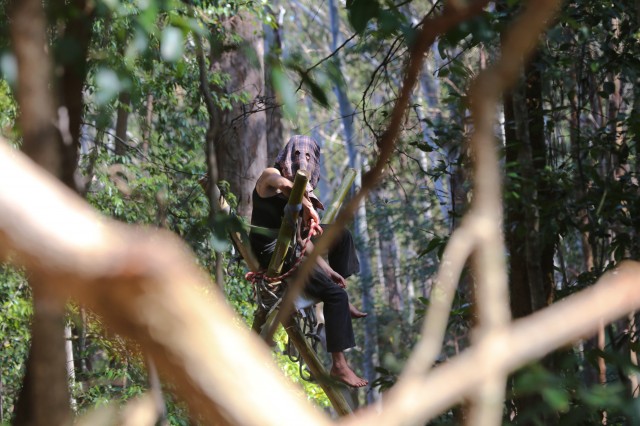 2013: Protester on a bamboo tripod on private land being logged at Whian Whian, near Terania Creek
Photo Jeff Dawson 2013: Protester on a bamboo tripod on private land being logged at Whian Whian, near Terania Creek
Photo Jeff Dawson
.
Tags: Community Direct Action, Direct action, Forestry Commission, Gondwana, Gondwana Rainforests of Australia World Heritage Area, Logging, New South Wales, Nightcap National Park, Nightcap Range, Northern Rivers, Rainforest protest, Rainforest Wars, Terania Blockade, Terania Creek, Terania Protest, Whian Whian
Posted in Threats from Deforestation | 3 Comments »
Add this post to Del.icio.us - Digg
Sunday, November 24th, 2013
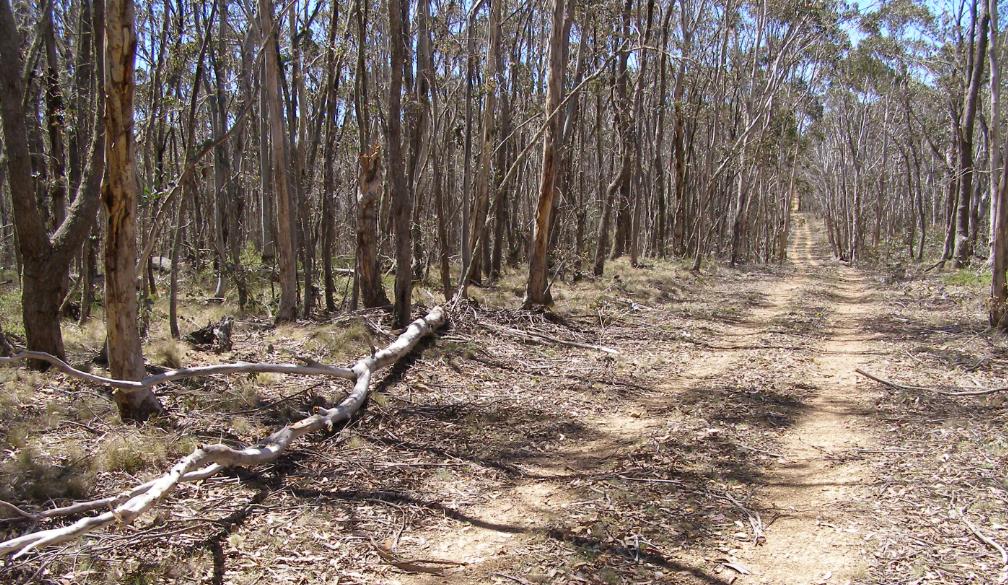 Kanangra Range, Kanangra-Boyd National Park Kanangra Range, Kanangra-Boyd National Park
[Photo by Editor 20131109, © under ^Creative Commons]
.
Budthingeroo
(a poem)
.
I could tell you a thing or two about Budthingeroo
About its mount, its bouldered ridge beyond
About its creek that carves through its lost ravine
All named after, Budthingeroo
About old Jimmy Whalan’s stock yards up on the wild Kanangra Range
Above where the Kowmung Cedars grew tall and the log moss grew thick
He’d well know how summer scorches its grassy woods
How its winters bite to the bone
Stunted yet happy Scribbly Gums thrive on the stoney soil
Holding on for dear life enduring the cold Oberon squalls
It’s much quieter these days up on Budthingeroo
The cedar men took their bounty
The cattle stockmen have long gone
The fires of ’29 took their toll of what was left of country
Now it’s wilderness of sorts across the Kanangra Range, cept for Rock Wallaby
Now it’s wilderness of sorts, cept for their escaped pigs and dogs
Or was Park’s Kanangra-Boyd just for thirsty Sydney, sterilised by cruel 1080?
A Sydney traveller can find the signs of the old colonial life
By passing through Luther and Budthingeroo
Past Whalan’s old paddocks, fences and greyed broken yards
And wonder ’bout the origin of Kanangra map’s many odd namings
A thousand stumps could tell you a thing or two about what happened at Budthingeroo.
.
 The cedar men took their bounty. The cattle stockmen have gone.
Kanangra Range, Kanangra-Boyd National Park
[Photo by Editor 20131109, © under ^Creative Commons] The cedar men took their bounty. The cattle stockmen have gone.
Kanangra Range, Kanangra-Boyd National Park
[Photo by Editor 20131109, © under ^Creative Commons]
.
by Editor, first recited 20131124, at a breakfast camp near Box Creek on the Boyd Plateau, Kanangra-Boyd National Park.
.
Thursday, February 14th, 2013
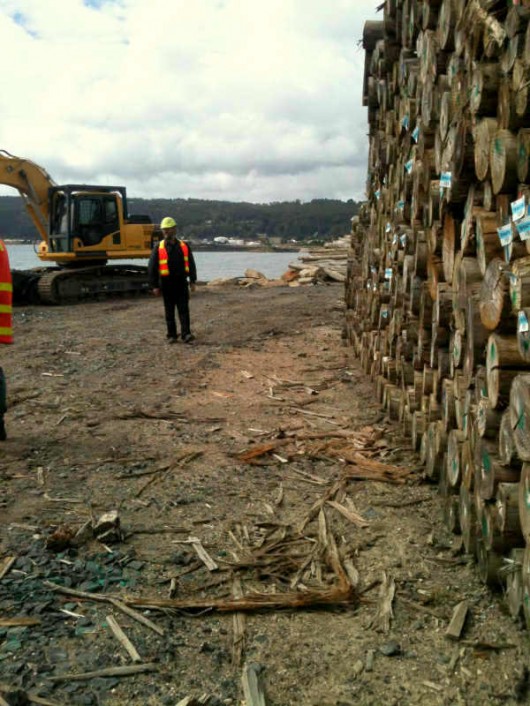 Dead native forest rotting for weeks/months on Burnie Wharf, Tasmania Dead native forest rotting for weeks/months on Burnie Wharf, Tasmania
13th February 2013
[Source: Tasmanian Times, 20130213,
^http://tasmaniantimes.com/index.php?/weblog/article/appalling-waste-of-eucalypt-and-speciality-timbers-at-burnie/]
.
The Tasmanian Greens (yesterday) condemned Forestry Tasmania’s appalling waste of valuable specialty timber species, which rots and splits on the Burnie wharf as sawmillers cry out for access to such a valuable resource.
Greens Forestry spokesperson Kim Booth MP today took a group of Tasmanian country sawmillers and timber merchants to inspect the growing mountain of logs on the Burnie wharf, which was delivered to the mill as valuable timber and now awaits export to China as virtually worthless split and cracking logs.
.
“There’s enough high value logs stacked up on the Burnie wharf right now to keep a generation of small family owned sawmills in business, but instead they are being sold into China as downgraded and virtually worthless whole logs,” said Mr Booth.
.
“We saw thousands of tonnes of Eucalypt, Blackwood, Myrtle, and black heart Sassafras all splitting up in the sun and going to waste.”
“Many of the logs were of the highest quality, with a dense grain and a rich colour and could have been turned into superb furniture, musical instruments, wooden boats and other high value sawn boards and building timber.”
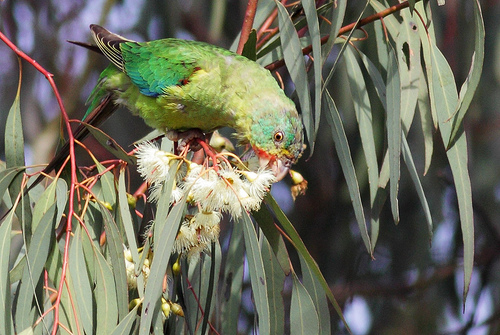 Swift Parrot (Lathamus discolor)
Listed as endangered under the Tasmanian Threatened Species Protection Act 1995 and the Federal Act.
Its favoured feed trees include winter flowering species such as Swamp Mahogany (Eucalyptus robusta), Spotted Gum (Corymbia maculata), Red Bloodwood (Corymbia gummifera), Mugga Ironbark (Eucalyptus sideroxylon), and White Box (Eucalyptus albens);
species targeted in Tasmania for logging.
[Source: Photo by 0ystercatcher on Flickr,
^http://www.birdlife.org/community/2010/11/hope-for-tasmania%E2%80%99s-forests/] Swift Parrot (Lathamus discolor)
Listed as endangered under the Tasmanian Threatened Species Protection Act 1995 and the Federal Act.
Its favoured feed trees include winter flowering species such as Swamp Mahogany (Eucalyptus robusta), Spotted Gum (Corymbia maculata), Red Bloodwood (Corymbia gummifera), Mugga Ironbark (Eucalyptus sideroxylon), and White Box (Eucalyptus albens);
species targeted in Tasmania for logging.
[Source: Photo by 0ystercatcher on Flickr,
^http://www.birdlife.org/community/2010/11/hope-for-tasmania%E2%80%99s-forests/]
.
“The sawmillers were rightly upset and dismayed that they have been unable to get hold of these logs because Forestry Tasmania simply will not sell them to them.”
“This puts the lie to the claim that there is a shortage of specialty timber logs in Tasmania.”
“The only specialty timber trees that are locked up at the moment in Tasmania are the ones lying horizontal and splitting in the sun behind a cyclone fence on the Burnie wharf and locked up for export by Forestry Tasmania.”
.
[Source: ‘Appalling waste of eucalypt and speciality timbers at Burnie’, by Kim Booth. MP Greens Forestry Spokesperson, 20130213, Tasmanian Times, ^http://tasmaniantimes.com/index.php?/weblog/article/appalling-waste-of-eucalypt-and-speciality-timbers-at-burnie/]
.
 . .
Comment by Posted by R. Langfield 20130213:
.
“Shut Forestry Tasmania down.
It’s nothing but a fully publicly subsidised, completely incompetently run, spitefully driven, mendicant not-for-profit club operated for the benefit of a select few overfed underworked bludgers of little or no intellect.
Forestry Tasmania and the Tasmanian Government are deliberately creating unemployment in the private forestry sector.“
.
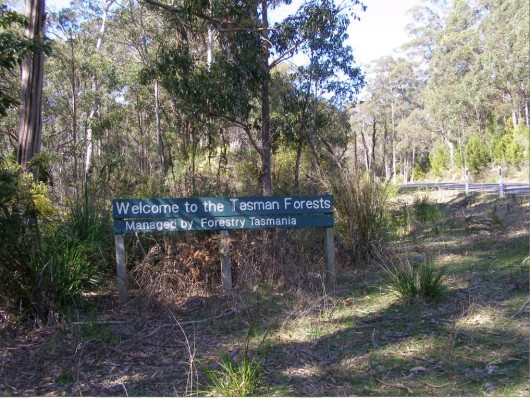 State Forest on Forestier Peninsula, south eastern Tasmania State Forest on Forestier Peninsula, south eastern Tasmania
Incinerated last month in the Forcett Fire
[Photo by Editor, 20110926, free in public domain]
.
Sunday, September 2nd, 2012
[The following article was written by Tigerquoll and initially published under the title ‘Anthology of State Serial Rape of Bermagui’s Spotted Gum Forest Habitat‘, on ^CanDoBetter.net 20100216]
 Click this image to play music
then click back to this article as it plays Click this image to play music
then click back to this article as it plays
.
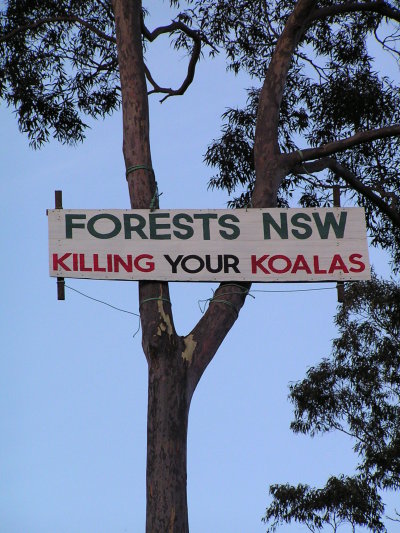 Nothing less than the Australian Government can be trusted to protect vital Koala Habitat.
Lesser smaller-minded state governments only see Koala Habitat as a logging and tourism resource.
Small minded politicians like Kristina Keneally can never be trusted with national treasures
Nothing less than the Australian Government can be trusted to protect vital Koala Habitat.
Lesser smaller-minded state governments only see Koala Habitat as a logging and tourism resource.
Small minded politicians like Kristina Keneally can never be trusted with national treasures
.
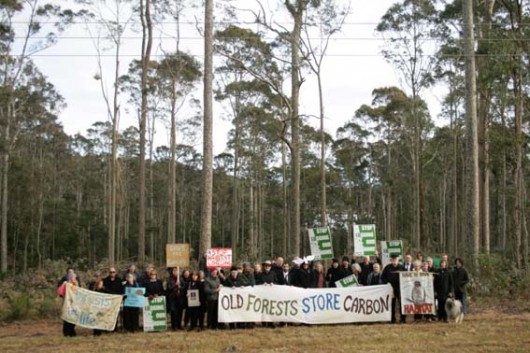 Bermagui’s Spotted Gums
..the local Narooma Community in their defence against ‘Forest NSW’ (the Forest-Fiddling loggers)
Bermagui’s Spotted Gums
..the local Narooma Community in their defence against ‘Forest NSW’ (the Forest-Fiddling loggers)
.
 Forest-Fiddling Logger driving his Spotted Gum spoils truck
Forest-Fiddling Logger driving his Spotted Gum spoils truck
.
 But Eucalyptus maculata is a tree, not a floor But Eucalyptus maculata is a tree, not a floor
.
In terms of Australia’s iconic ‘Spotted Gum’, the word “spotted” refers to the soft mottled colour caused by weathering of the outer tree as it sheds elliptical strips of bark.
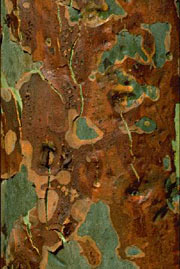 Spotted Gum bark Spotted Gum bark
.
This colour varies from pale greybrowns and soft creams to a rich chocolate brown. A very tough timber, its frequent wavy grain can produce an attractive and highly valued fiddleback effect. [Source: Boral website, ^http://www.boral.com.au/timberflooring/timber_species_-_spotted_gum.asp]
.
 Build something great, but don’t destroy something great in the process
– like Koala Spotted Gum Forests!
Invest in Boral and you invest in Koala extinction
Build something great, but don’t destroy something great in the process
– like Koala Spotted Gum Forests!
Invest in Boral and you invest in Koala extinction
.
About 380km south of Sydney lies what NSW Tourism labels the beautiful ‘Sapphire Coast’ with the popular seaside town of Bermagui.
Less than 3km north of Bermagui heading north along Bermagui-Cobargo Road and up the Bermagui River estuary is the Bermagui State Forest – a label by the NSW Department of Primary Industry (DPI) given to magnificent Spotted Gum forest.
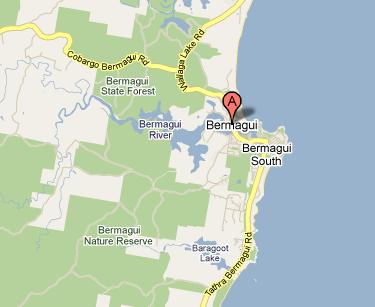 . .
This forest is vital habitat for threatened native fauna – the Yellow Bellied Gliders, Grey-Headed Flying Foxes, Tiger Quolls, Sooty Owls, Sea Eagles, Possums and Australia’s iconic Koala.
.
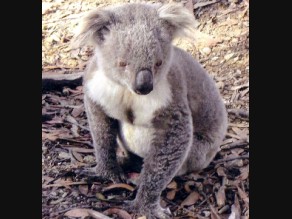 Koala in Bermagui’s Spotted Gum forest – a displaced landlord
Koala in Bermagui’s Spotted Gum forest – a displaced landlord
.
Australia’s iconic ‘Spotted Gums’
.
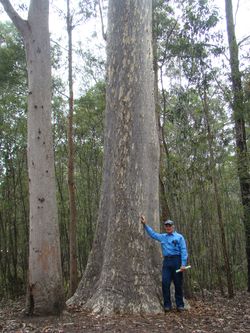 A mature iconic Spotted Gum Tree
About 400 years old, about 30 metres high
A mature iconic Spotted Gum Tree
About 400 years old, about 30 metres high
[Source: ‘A gum tree that saw Captain Cook and before’, ABC Radion interview of John Knight by Ian Campbell, 20100119,
Listen to Interview: ^http://blogs.abc.net.au/nsw/2010/01/a-gum-tree-that-saw-captain-cook-and-before.html]
.
Australia’s magnificent and unique Spotted Gums are naturally distributed in open forests along the hilly coastal corridor from south-east Queensland down through New South Wales and with a few isolated pockets in East Gippsland, Victoria. They belong to the botanical family ‘Myrtaceae’ and grow straight and tall up to 40 metres. Their height attracts roosting by Sea Eagles.
 Note the planet’s sole natural distribution of Spotted Gum Forests
They have become the target of corporate development simply because Spotted Gums prefer a mild temperate climate near the coast
..like Australia’s millions of breeding humans, and profiteering corporate developers
Note the planet’s sole natural distribution of Spotted Gum Forests
They have become the target of corporate development simply because Spotted Gums prefer a mild temperate climate near the coast
..like Australia’s millions of breeding humans, and profiteering corporate developers
.
Spotted gums flower once every two years and produce a rich pollen that attracts native birds such as Lorikeets and Yellow Tailed Cockatoos as wells as possums and flying foxes including the IUCN vulnerable listed Grey-Headed Flying Fox. [Source: Australian Native Plants Society, Corymbia maculata, ^http://asgap.org.au/c-mac.html]
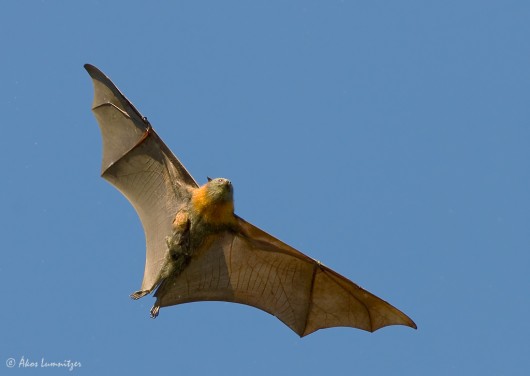 Grey-Headed Flying Fox (Pteropus poliocephalus)
The grey-headed flying-fox is listed as vulnerable to extinction under NSW and Australian legislation because of declining numbers and key threats such as habitat loss and urban conflict. Records indicate that grey-headed flying-foxes may once have numbered in the millions, but are now reduced to as few as 400,000. In the decade before listing, their population was estimated to have declined by 30%.
(Photo by Ákos Lumnitzer, ^http://amatteroflight.com/) Grey-Headed Flying Fox (Pteropus poliocephalus)
The grey-headed flying-fox is listed as vulnerable to extinction under NSW and Australian legislation because of declining numbers and key threats such as habitat loss and urban conflict. Records indicate that grey-headed flying-foxes may once have numbered in the millions, but are now reduced to as few as 400,000. In the decade before listing, their population was estimated to have declined by 30%.
(Photo by Ákos Lumnitzer, ^http://amatteroflight.com/)
.
Unlike the declaration of a ‘National Park’ which affords federal environmental protection to forest habitat, the State label of a ‘State Forest’ is a misnomer. A ‘State Forest’ is deemed a timber and woodchip resource for logging. The same public relations label is used across New South Wales, ACT, Victoria, Western Australia, Tasmania and Queensland. A State Forest is not treated as a forest for its natural habitat values, but rather as a logging coup on death row, that can be chainsawed at will anytime. Perhaps ‘Death Row Forest’ is a more apt label than speaking the State euphemism of ‘State Forests’.
And its public relations label logging as ‘harvesting’, a euphemism to belie the destructive reality.
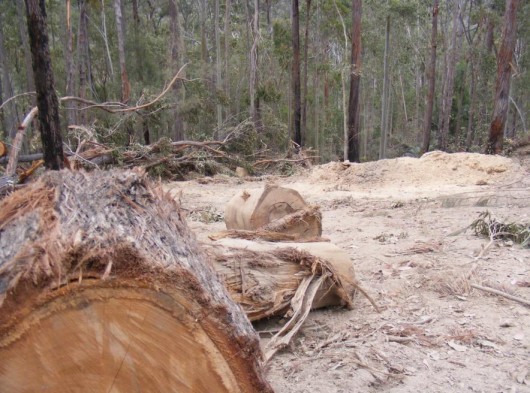 Bermagui State Forest after the loggers Bermagui State Forest after the loggers
.
The NSW Logging Offensive of 1988
.
On the back of a century of clear felling Bermagui State Forest was logged in the late 1980s. Then according to data from the ‘Bureau of Resource Science‘ (aka science graduates on the payroll of loggers), 148ha were “thinned” in 1996, and another 133ha that same year, then 94ha in 1999.
Typically 70% of the spotted gums goes to Boral’s mills in Narooma, Nowra and Batemans Bay as sawlogs to be processed into mainly flooring. The remainder end up as woodchips at Nippon Paper’s woodchip mill at Twofold Bay for export to Japan.
So Australia’s precious endangered habitat is being destroyed for house flooring and office paper. .
.
The NSW Logging Offensive of 2008
.
In October 2008, NSW Forests logged what it labeled “two compartments” in Bermagui State Forest north of Bermagui. It justified this under the infamous Eden Regional Forest Agreement (RFA). [>Read Agreement] [Source: ^http://www.daff.gov.au/__data/assets/pdf_file/0009/51021/nsw_rfa_eden.pdf]
This RFA is one of three established in 1999, in which the NSW Government relegated 15.1 million hectares of native forests across New South Wales for logging anytime. The usual public relations spin preceded the logging. Southern Region manager of Forests NSW, Ian Barnes.
It was at this time that Labor’s Minister for Primary Industries (Forests NSW) Ian MacDonald and Labor’s Minister for Police Tony Kelly started to use Dick Cheney tactics to push their weight around with protesters. The following questions to the NSW Legislative Council by NSW Greens Senator Lee Rhiannon on 28th October 2008, highlight the escalated use of law enforcement into a heavy handed riot squad:
.
Lee Rhiannon MLC:
“I direct my question to the Minister for Police. Did officers stationed at Batemans Bay police station in collaboration with Forests New South Wales hold a meeting at the Bermagui Country Club in September to warn locals associated with calling for forest protection not to protest when logging commenced in the Bermagui State Forest? Does the holding of this meeting reflect that Batemans Bay police officers have adopted a zero tolerance policing approach to forest protesters? Considering that since logging started in Bermagui State Forest on 27 October with a group of about 40 protesters gathered in the vicinity, about 15 police cars, more than 20 police, including members of the Public Order and Riot Squad, a mobile police command bus and two police rescue vans have been in attendance, will this level of policing continue for the coming six weeks of logging in this area? What is the anticipated cost of this operation?
.
Tony Kelly MLC (response):
“The Far South Coast Local Area Command of the New South Wales Police Force has been advised that New South Wales Forests is to commence logging compartments of Bermagui State Forest later this month. As in the past, protests are expected. As always, the New South Wales Police Force is committed to maintaining public order. For this reason, local police and various commands, including the Public Order and Riot Squad, Highway Patrol and Rescue Squad will join together to conduct an operation.
This operation will focus on ensuring the protection of persons engaged in lawful activities. Local police have made it clear that anyone engaging in unlawful or dangerous activity in or near the logging operation will have action taken against them. When offences continue and are considered dangerous, police will arrest and charge people as necessary. Police respect people’s rights to protest during these times; in no way are they looking to prevent lawful and peaceful protests. Police have asked anyone who intends to protest to contact them so that they can attempt to facilitate lawful activity, minimise disruption and focus on protecting the safety of everyone involved.”
.
[SOURCE: ‘Bermagui State Forest Logging Protests‘, Question raised NSW Legislative Council by The Greens Senator Lee Rhiannon, Parliament of New South Wales, Hansard, 20081028, ^http://www.parliament.nsw.gov.au/prod/parlment/hanstrans.nsf/V3ByKey/LC, 20081028, >Read Hansard Extract – go to page 10631, PDF, 344kb ]
.
The NSW Logging Offensive of Feb 2009
.
On Monday 2nd February 2009, logging operations resumed in the Bermagui State Forest after the summer holiday break period and continued for about two months.
Bruce Mathie and Sons is one of the prominent loggers in the area, but most timber finds its way either as saw logs to Boral for Spotted Gum flooring or else to Nippon Papers woodchip mill at Twofold Bay, Eden for export to Japan.
The forest eco-rapers ‘Forests NSW’ – bulldozed, chainsawed, logged, then left with their booty.
.
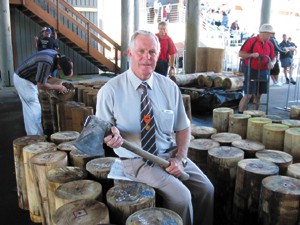 Kevin Mathie – 4th generation logger Kevin Mathie – 4th generation logger
.
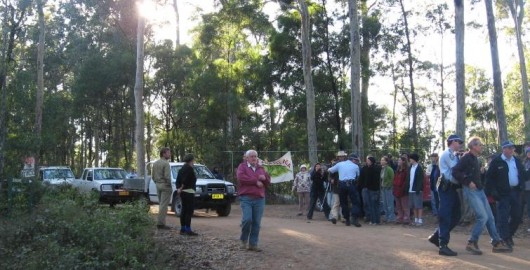 Logging contractor, Gil Mathie, in the middle of the picture at front (pink jumper)
More notably, this editor is saddened by bearing witness to a senior member
of the Bermagui community being arrested for conserving Spotted Gums and Koalas.
We love, we defend, we act for love.
Salute the man being arrested.
[Source: Local environmentalist, John Perkins, Gulaga Protest near Tilba on the NSW South Coast, 20070514]
Logging contractor, Gil Mathie, in the middle of the picture at front (pink jumper)
More notably, this editor is saddened by bearing witness to a senior member
of the Bermagui community being arrested for conserving Spotted Gums and Koalas.
We love, we defend, we act for love.
Salute the man being arrested.
[Source: Local environmentalist, John Perkins, Gulaga Protest near Tilba on the NSW South Coast, 20070514]
.
Labor’s Ian MacDonald’s Forestry Regulation of 2009
.
But rather that do the right thing by the Environment and by the Community and obey the law of the land, those in power The Labor Government’s (Forests NSW) forced changes to the law of the land to bloody well suit themselves. Arguably reminiscent of England’s King Henry VIII changing laws to accommodate his adultery, or Joh Bjelke-Petersen’s gerrymandering that secured his electoral hold on power.
In order to keep the cameras and local conservationist away from the loggers destructive practices, Forests NSW got the Minister to legislate an exclusion area around its logging with the public relations labeling of “mainly for safety reasons”.
On 1 September 2009, the NSW Forestry Regulation 2009 came into force making it illegal for anyone to trespass into areas marked by NSW Forests for logging. This has given Forests NSW absolute logging power with the police as its enforcement lackies.
Forests NSW Minister for Primary Industries, Ian MacDonald, tabled the Bill and it became law preventing democratic protests by people trying to save important habitat from destruction. It has given loggers free reign to log State Forests with impunity.
Under Part 3, Division 1, Clause 11 of this Regulation, a logger has legal authority to request anyone to leave a forestry area and this includes if that person “causes inconvenience.”
Under Clause 12, a logger can forcible remove anyone from a forestry area “who is causing annoyance or inconvenience.”
Surely such removal by a logger can be construed an assault under the Crimes Act? It is draconian. It is certainly an assault on Australians’ democratic right to protest. What was Ian MacDonald thinking?
.
Labor’s Ministers in charge three years hence…
.
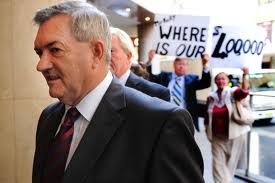 Labor’s Police Minister Tony Kelly MLC
NSW Minister for Emergency Services, Lands, Police and Primary Industries.
Labor’s Police Minister Tony Kelly MLC
NSW Minister for Emergency Services, Lands, Police and Primary Industries.
.
‘Tony Kelly was targeted by protesters as he arrived to give evidence at the ICAC in June. Today the commission has found the former minister engaged in corrupt conduct.’
[Source: Protesters target Kelly outside ICAC’, by Dean Lewins, AAP, 20111212, ^http://www.abc.net.au/news/2011-12-12/protesters-target-kelly-outside-icac/3725744]
.
‘DISGRACED former state Labor ministers Tony Kelly and Ian Macdonald are demanding taxpayers foot their legal bills and the state government could be forced to hand over up to $250,000. Despite being found by corruption watchdog ICAC to have forged official documents while a minister, Mr Kelly has formally asked the O’Farrell government to cover the cost of his elite legal team.’
[Source: ‘Disgraced former Labor ministers Tony Kelly and Ian Macdonald demand taxpayers foot their bills’, by Barclay Crawford, Daily Telegraph, 20120101, ^http://www.dailytelegraph.com.au/news/disgraced-former-labor-ministers-tony-kelly-and-ian-macdonald-demand-taxpayers-foot-their-bills/story-e6freuy9-1226234077573].
.
 Labor’s Logging Minister Ian MacDonald MLC
Forests NSW/ Minister for Primary Industries in 2009 Labor’s Logging Minister Ian MacDonald MLC
Forests NSW/ Minister for Primary Industries in 2009
.
‘The disgraced former NSW resources minister Ian Macdonald is to face a new corruption inquiry into the granting of coal exploration licences. The Independent Commission Against Corruption said in a statement yesterday that Mr Macdonald is being investigated for allegedly using his ministerial position ”to advantage the private interests of others”.
[Source: ‘ICAC to examine mining licences‘, by Kate McClymont, Senior Reporter, Sydney Morning Herald, 20120524, ^http://www.smh.com.au/nsw/icac-to-examine-mining-licences-20120523-1z5ov.html‘]
.
‘The senior state minister Ian Macdonald signed taxpayers up to the V8 Supercars race without a system to manage potential conflicts of interest, without advice from the government’s major events body and without a proper business case, the NSW Auditor-General finds.’
[Source: ‘Mate’s race: $45m deal snares MP‘, by Anne Davies, Linton Besser and Nick O’Malley, 20100529, ^http://www.smh.com.au/nsw/mates-race-45m-deal-snares-mp-20100528-wldb.html]
.
The NSW Logging Offensive of Sep 2009
.
In September 2009, Forests NSW commenced logging again in Bermagui State Forest, like pack rapists marauding through a maternity ward.
Sure enough, on Monday, 14th September 2009, Police arrested two of four forest campaigners who had allegedly entered Bermagui State Forest in what Forests NSW had labeled logging compartments 2001 and 2002. Apparenpe known to support koalas is unacceptable, particularly when the NSW government cannot prove their claims that koalas can be found anywhere in the south east,” said Robert Bertram, local Friends of Five Forests member.
“This is yet another example of Forests NSW lack of care for community and the environment,” said Lisa Stone, spokesperson for South East Forest Rescue.
“They are logging old-growth in Dampier, threatened species habitat in South Brooman, endangered species habitat in Nadgee and now this.”
“The loss of biodiversity coupled with logging and burning means the condition of many forests is as bad as the endangered ecological communities on private land, unable to support most threatened and endangered species and unable to recover.”
“We urge the newly appointed Minister for the Environment, Mr John Robertson, to step in on behalf of the native forests and their dependents and stop these archaic practices.”
“The current government policy of destroying habitat to satisfy ‘wood supply agreements’ is robbing from the future generations their chance of survival. The amount of breaches was astounding and shows that Forests NSW cannot be trusted to log these important areas of Koala habitat.”
“We have inspected many other logging operations in the past year and have found the same breaches everywhere we have looked. This is pe known to support koalas is unacceptable, particularly when the NSW government cannot prove their claims that koalas can be found anywhere in the south east,” said Robert Bertram, local Friends of Five Forests member.
“This is yet another example of Forests NSW lack of care for community and the environment,” said Lisa Stone, spokesperson for South East Forest Rescue.
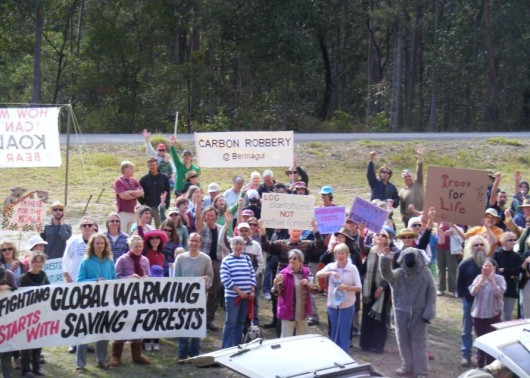 A community morally right to defend habitat and prepared to defend that right A community morally right to defend habitat and prepared to defend that right
.
“They are logging old-growth in Dampier, threatened species habitat in South Brooman, endangered species habitat in Nadgee and now this.”
“The loss of biodiversity coupled with logging and burning means the condition of many forests is as bad as the endangered ecological communities on private land, unable to support most threatened and endangered species and unable to recover.”
“We urge the newly appointed Minister for the Environment, Mr John Robertson, to step in on behalf of the native forests and their dependents and stop these archaic practices.”
“The current government policy of destroying habitat to satisfy ‘wood supply agreements’ is robbing from the future generations their chance of survival. The amount of breaches was astounding and shows that Forests NSW cannot be trusted to log these important areas of Koala habitat.”
“We have inspected many other logging operations in the past year and have found the same breaches everywhere we have looked. This is not a once off mistake but a systemic disgust for any environmental protection measures.”
Conservationists state the native forest logging industry is unsustainable and only propped up by political will, public subsidies and union backing.
Spokesperson for the South East Region Conservation Alliance, Pru Acton, says:
“The significant social and economic costs of reduced biodiversity can only increase while our natural systems are poorly managed.”
“Credible experts agree that the cost of logging this habitat is not only the last few koalas, but also potable water supplies, oysters, the inspiration for the local artists community, and another chunk of the Wilderness Coast’s tourism potential.”
“It seems the NSW Government has now decided its contractual obligations to supply sawlogs locally and woodchips to Asia is more important then protecting this much loved native animal.”
.
South East Region Conservation Alliance
.
Conservationists state the native forest logging industry is unsustainable and only propped up by political will, public subsidies and union backing.
Spokesperson for the South East Region Conservation Alliance, Pru Acton, says: “The significant social and economic costs of reduced biodiversity can only increase while our natural systems are poorly managed.”
“Credible experts agree that the cost of logging this habitat is not only the last few koalas, but also potable water supplies, oysters, the inspiration for the local artists community, and another chunk of the Wilderness Coast’s tourism potential.”
“It seems the NSW Government has now decided its contractual obligations to supply sawlogs locally and woodchips to Asia is more important then protecting this much loved native animal.”
.
[Source: ‘Logging resumes at Bermagui’, by Stan Gorton Narooma News, 20090204 – note the Narooma News has removed this news item online. However, the Narooma News has chosen not to remove its following story (Source: ^http://www.naroomanewsonline.com.au/story/191381/albino-possum-causes-log-truck-roll-over-at-narooma/ if it be not similarly removed].
 Speeding logging trucker blames possum
..Narooma News editor’s reputation shot Speeding logging trucker blames possum
..Narooma News editor’s reputation shot
.
Narooma News spins the following story to appease local logger readership:
.
“In a bizarre set of circumstances, a rare but dead albino possum is believed to have caused a log truck roll-over on the Princes Highway just south of Narooma.
The accident occurred just after 1pm when witnesses said a local from Wallaga Lake stopped to look at the road-kill possum that had been lying on the roadside at the entrance to the Island View Beach Resort.
A series of cars backed up behind the stopped vehicle in the southbound lane. Another Narooma local who was last in the line of stopped cars looked in his rear-vision mirror only to see the huge red-coloured truck coming up fast from behind.
“I think I am going to buy a lottery ticket,” said the local, who at one point thought the truck was going to smash into him and end his life.
The truck driver then allegedly swerved onto the wrong side of the road, narrowly missing the line of cars and while he was fortunate not to face any oncoming northbound traffic, he did lose control on the straight stretch of highway.
The truck reportedly clipped a boat trailer, flipped onto its side, sliding down the highway with the prime mover coming to rest in bushland just off the verge north of the Nangudga Bridge.
An ACT couple who among those first on the scene were able to help the truck driver out of the cab but they said he was badly shaken up and was not aware of where he was.
The Pambula man was the only person injured in the accident and was taken to Moruya Hospital for treatment.
The highway was closed down to one lane with firefighters, police and RMS personnel cleaned up and investigated the scene.
Residents from the nearby Island View caravan park were alerted to the accident by a loud bang and they lined the highway watching the accident.
The accident occurred at the start of the June long weekend where NSW police were out in force urging drivers to be careful on the busy roads.
Albino or golden brush-tailed possums are very rare but there is a known population living in the Narooma area.’
.
~ by the Narooma News editor…and watch out for drop bears too!
.
Meanwhile NSW Forests remains culturally contemptuous to NSW forests
.
Forests NSW recruit their students with Communications degrees to lie for it on its website:
“State forests in NSW are managed sustainably to provide a supply of timber today and into the future, to protect the environmental values of the forest and provide community amenities.”
Forests NSW website claims that “Ecologically sustainable forest management (ESFM) is our guiding philosophy. ESFM is about managing forests to maintain ecological principles and biodiversity while optimising the benefits to the community from all uses of the forest…”
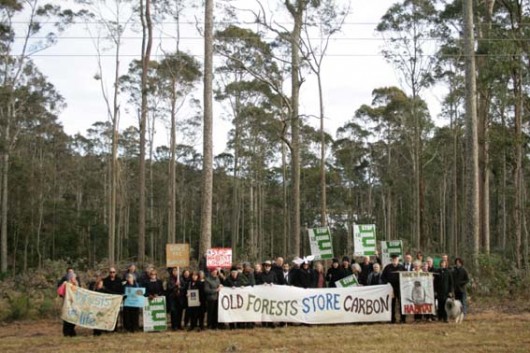 Narooma Community in defence of Koala Habitat
– clearly not convinced about Forests NSW spiel about “optimising the benefits to the community” Narooma Community in defence of Koala Habitat
– clearly not convinced about Forests NSW spiel about “optimising the benefits to the community”
.
Revolving Door politics of NSW Labor
.
In the revolving door politics of NSW Labor, Premier #3 Nathan Rees on 16th November 2009 sacked Ian MacDonald from his DPI Ministry.
Rees was himself sacked as premier on 3 December, then a week later, Labor Premier #4 Kristina Keneally (Labor show pony) reappointed Ian MacDonald ‘Minister for State & Regional Development and Minister for Mineral & Forest Resources‘ in December 2009.
The labelling of Minister for ‘Forest Resources’ left NSW State Forests in no doubt about the death row status. Throughout NSW Labor’s factional power shuffle Macca’s chair never got cold.
The then Minister for Primary Industries , Tony Kelly, overseeing Forests NSW, claimed on 18 November 2009: “The NSW Government has a solid track-record for maintaining prosperous and sustainable primary industries, I will be working hard with industry to ensure this tradition continues.”
.
[Source: Source: NSW Department of Primary Industries, ^http://www.dpi.nsw.gov.au/__data/assets/pdf_file/0019/308251/Minister-Kelly-Visits-Industry-and-Investment-NSW-Headquarters.pdf, since deleted by the NSW Government – the file, not the department unfortunately]
.
Tigerquoll’s Position
.
All State Forests should be added to Australia’a National Park Estate. State Governments and their narrow mindset culture cannot be trusted with ecology. Boral and Nippon Paper can transition their logging operations into plantation-only FSC resources.
The Twofold Bay Woodchip Mill was set up near Eden in 1969 by Daishowa Paper Manufacturing Company has exported and profitted from over 35 million tonnes of Australian native forest woodchips, mostly to Japan, where its parent company is based.
In contributing to the annihilation of thousands of hectares of Australia’s native forest habitat the Daishowa Twofold Bay Woodchip Mill is Australia’s Habitat Auschwitz. It must be unceremoniously closed down immediately.
 Daishowa – Japan’s BIG Corporate Eco-Rapist and BIG Koala Exterminator Daishowa – Japan’s BIG Corporate Eco-Rapist and BIG Koala Exterminator
.
 Boral Spotted Gum – corporate shareholder perspective
. Boral Spotted Gum – corporate shareholder perspective
.
 Spotted Gums too magnificent to kill
[Source: Save Our Water Ways Now, photo by Robert Whyte,
^http://www.saveourwaterwaysnow.com.au/01_cms/details_pop.asp?ID=135] Spotted Gums too magnificent to kill
[Source: Save Our Water Ways Now, photo by Robert Whyte,
^http://www.saveourwaterwaysnow.com.au/01_cms/details_pop.asp?ID=135]
.
Further Reading:
.
[1] South East Region Conservation Alliance, ^http://www.serca.org.au/
.
[2] ‘South East Forests must be protected’, by Greens MP David Shoebridge, 20110629, ^http://davidshoebridge.org.au/2011/06/29/south-east-forests-must-be-protected/
.
‘Greens MP David Shoebridge today met with local campaigners and timber workers in the Bermagui State Forest to get a first-hand view of the impact of continued logging in the South East Forests.

“There is a real concern that this logging is further fracturing the remaining stands of koala habitat in the South East,” Mr Shoebridge said.
“The logging is being undertaken in a nature corridor that links Wallaga Lake National Park and Bermagui Nature reserve. This corridor should be protected.
“With the logging at Bermagui coming within a few hundred meters of town the prospects of more intensive and drier regrowth producing higher levels of fire hazard are real.

“Forests NSW has said that the beautiful “cathedral” entrance to Bermagui will be protected. However on closer inquiry only a small part of the western side and a 50m ‘visual protection zone’ to the east is currently protected.
“In discussions with Forests NSW today they have committed to reviewing the decision on the cathedral to consider protecting all of it from logging. This would be a welcome, if modest, concession.
“The South East Forests are a priceless natural asset and this new State government has a real chance to break with the past and save them from continued logging for wood chips.
“Local campaigners are committed to saving these beautiful forests and this will remain a key focus in the coming years,” Mr Shoebridge said.
.
[Ed: That was over a year ago – our love and commitment for the old forest – we remember ]
.
Tags: Bermagui Community, Bermagui State Forest, Boral, Build something great, Eucalyptus maculata, Forest-Fiddling Loggers, Forests NSW, Grey-Headed Flying Foxes, Ian Macdonald, koala habitat, Kristina Keneally, Logging, Narooma Community, Sapphire Coast, Save the Koala, South East Corner, South East Forest Rescue, Spotted Gum
Posted in Koalas, Possums and Gliders, Quolls, South East Corner (AU), Threats from Deforestation | No Comments »
Add this post to Del.icio.us - Digg
Monday, May 14th, 2012
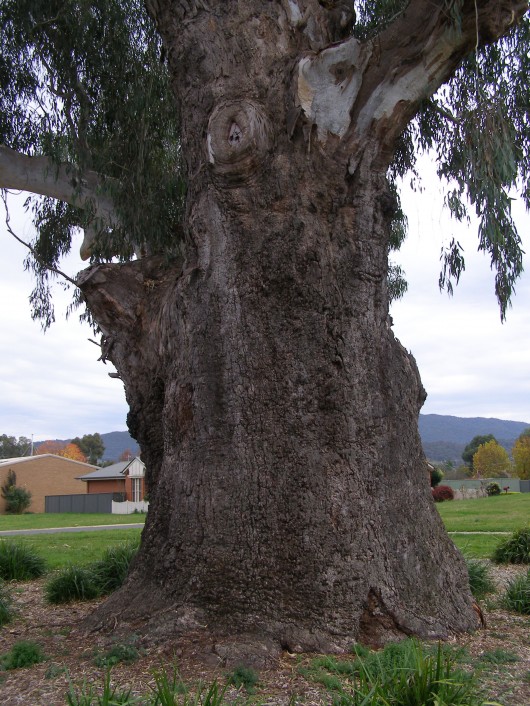 River Red Gum
(click image to enlarge) River Red Gum
(click image to enlarge)
.
Play music by Australia’s David Hyams: 
[Music source: ^http://www.milestogo.com.au/]
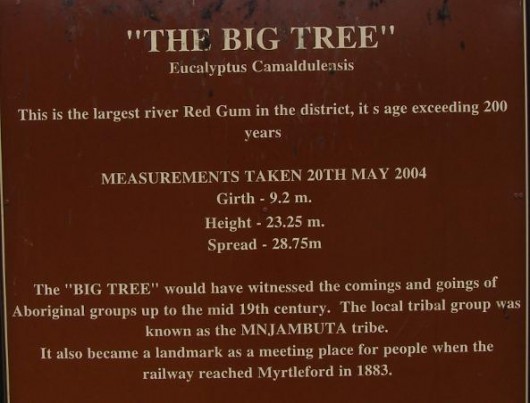
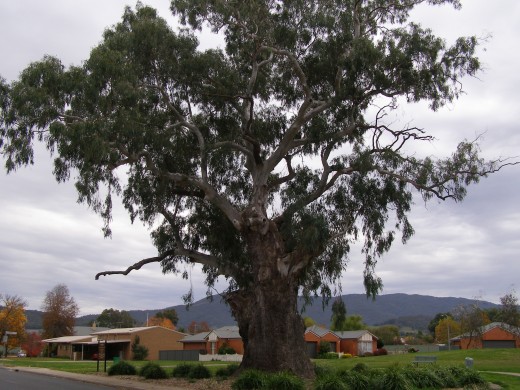 Myrtleford’s 200+ year old River Red Gum
(Eucalyptus camaldulensis) Myrtleford’s 200+ year old River Red Gum
(Eucalyptus camaldulensis)
.
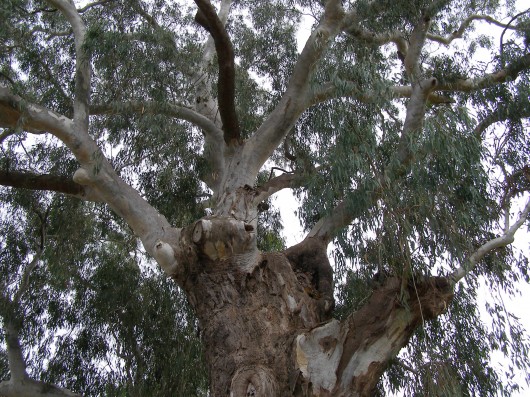 Native to riverine valleys particularly of heavy clay soils along river banks and on floodplains subject to frequent or periodic flooding across riverine northern Victorian and southern New South Wales.
Native to riverine valleys particularly of heavy clay soils along river banks and on floodplains subject to frequent or periodic flooding across riverine northern Victorian and southern New South Wales.
.
Most Australian trees, like native Australians, have otherwise been despised and slaughtered by Colonists…
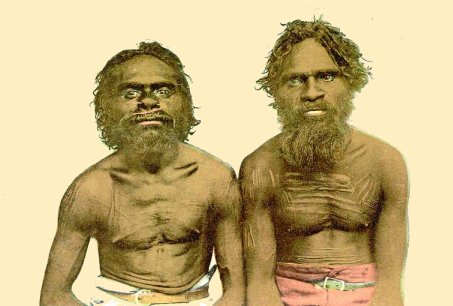 Indigenous Australians Indigenous Australians
.
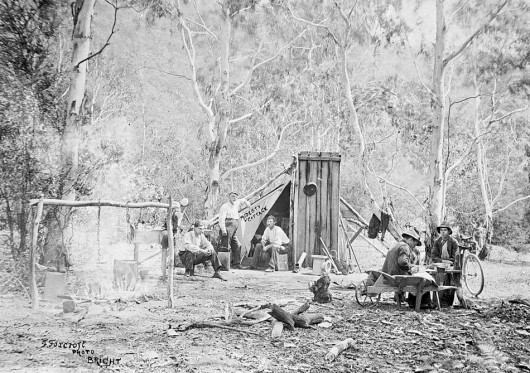 The township of Bright before the exotic trees.
In the 1890s when colonial miners exploited North East Victoria..
the Red Gum would have been just 80 years old.
. The township of Bright before the exotic trees.
In the 1890s when colonial miners exploited North East Victoria..
the Red Gum would have been just 80 years old.
.
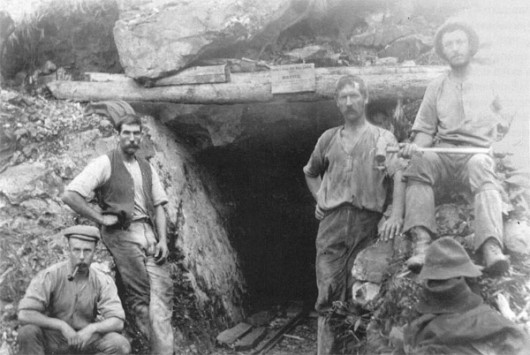 . .
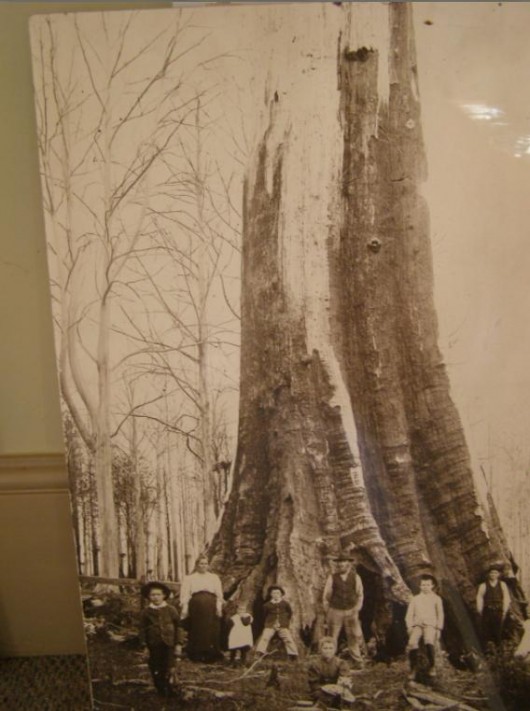 The ‘Penny Tree’
[Fumina, East Gippsland, Victoria, 1908] The ‘Penny Tree’
[Fumina, East Gippsland, Victoria, 1908]
.
..”As a result of the devastating bush fires which raged through Gippsland some 18 months ago, this Settler in the Fumina district was unfortunate enough to lose his home, and afterwards took shelter in this big hollow tree.
The space available was enough for 2 large beds, tables, chairs and sundry other furniture. Under the deft fingers of “The Lady of the Tree” it soon transofrmed into a comfortable home for the Family, until eventually replaced by a 6 roomed home some time later.”
[Source: The Weekly Times, 1908]
.
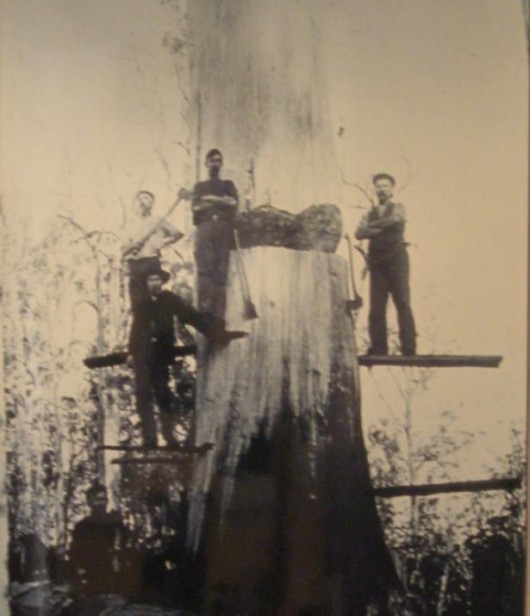 . .
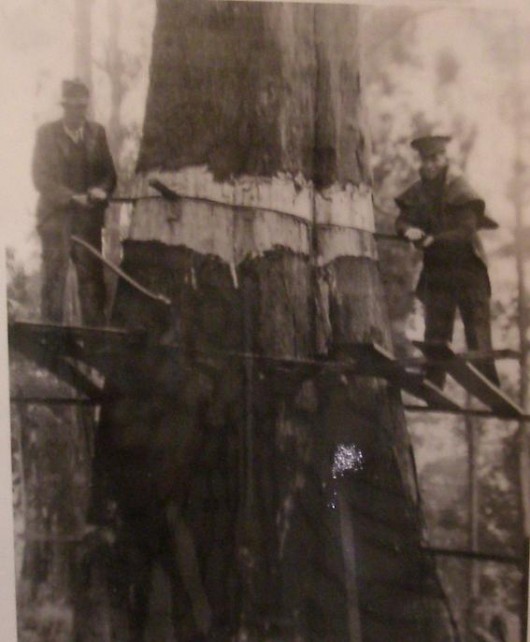
[Source: Forestry Museum, Beechworth, Victoria, Australia]
.
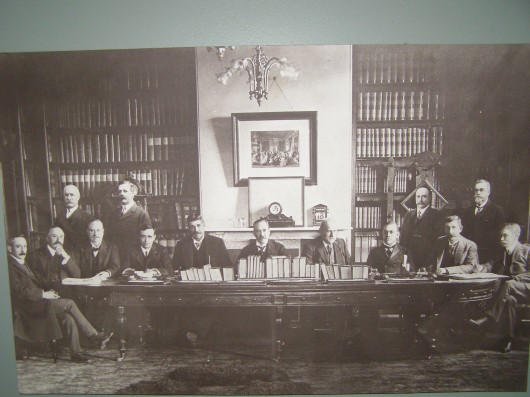 Victorian colonists driving ‘COLONIAL PROGRESS‘
(click image to enlarge) Victorian colonists driving ‘COLONIAL PROGRESS‘
(click image to enlarge)
.
Tags: Australia's old growth, Bright, colonial progress, East Gippsland, Eucalyptus camaldulensis, Fumina District, Logging, Mnjambuta, Myrtleford, North East Victoria, Penny Tree, River Red Gums, The Big Tree
Posted in Threats from Deforestation | 2 Comments »
Add this post to Del.icio.us - Digg
Thursday, February 23rd, 2012
The following article is a press release by UK-based NGO, The Environmental Investigation Agency (EIA), of 20120124 entitled ‘Conservation on the Front Line – Muara Tae’s Last Stand Against Big Palm Oil’
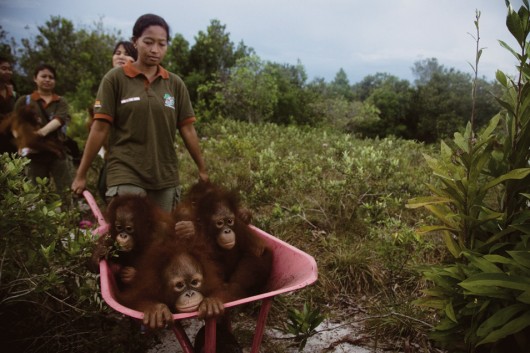 Their ancient rainforest home clearfelled for bloody Palm Oil,
now these Orang-utans are homeless in their own homeland
[Source: ^http://www.pdnphotooftheday.com/2010/05/4673]
(Click photo to enlarge) Their ancient rainforest home clearfelled for bloody Palm Oil,
now these Orang-utans are homeless in their own homeland
[Source: ^http://www.pdnphotooftheday.com/2010/05/4673]
(Click photo to enlarge)
.
MUARA TAE, EAST KALIMANTAN (Borneo, Indonesia):
The fate of a Dayak indigenous community, deep in the interior of East Kalimantan (Borneo) demonstrates how Indonesia must safeguard the rights of indigenous people if it is to meet ambitious targets to reduce emissions from deforestation.
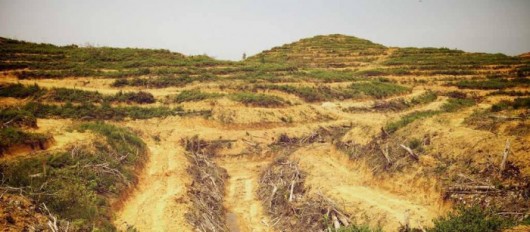 Cleared land at Muara Tae
(c) EIA/Telapak Cleared land at Muara Tae
(c) EIA/Telapak
.
The Dayak Benuaq of Muara Tae, in West Kutai Kabupaten (Indonesia), today face a two-pronged assault from palm oil companies aggressively expanding into their ancestral forests. Together with Indonesian NGO Telapak, the community is manning a forest outpost around the clock in a last ditch attempt to save it from destruction.
The London-based Environmental Investigation Agency (EIA) has witnessed at first-hand the Dayak Benuaq’s struggle, and how their sustainable use of forests could help Indonesia deliver on its ambitious targets to reduce greenhouse gas emissions.
EIA Forests Team Leader Faith Doherty said: “There are more than 800 families in Muara Tae relying on the forests for their food, water, medicine, culture and identity. Put simply, they have to keep this forest in order to survive.
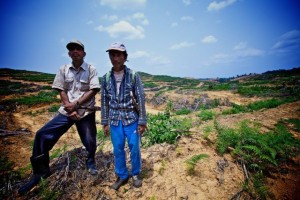 Villagers on cleared land at Muara Tae
(c) EIA/Telapak Villagers on cleared land at Muara Tae
(c) EIA/Telapak
.
“The rhetoric from the President of Indonesia on curbing emissions by reducing deforestation is strong but on the front line, where indigenous communities are putting their lives at risk to protect forests, action is sorely missing.
“Giving these communities, such as the Dayak Benuaq, the rights they deserve is a vital step to reduce catastrophic levels of deforestation in Indonesia.”
President Yudhoyono has pledged to reduce carbon emissions across the archipelago by 26 per cent by 2020 against a business-as-usual baseline, alongside delivering substantial economic growth.
 Self-serving bullshit artist
– take your pick Self-serving bullshit artist
– take your pick
.
Plantation expansion will inevitably be a significant element of growth, but it has historically been a major driver of emissions and it is widely acknowledged that in order avoid them, expansion must now be directed to ‘degraded’ lands.
As a result of weak spatial planning, however, the forests of Muara Tae are identified as ‘APL’, a designation meaning they are not part of the national forest area and are open to exploitation. The theft of indigenous forests also raises serious questions as to what form of ‘development’ these plantations offer.
In indigenous communities such as the Dayak Benuaq of Muara Tae, Indonesia has perhaps its most valuable forest resource. It is due to their sustainable methods, honed over generations, that the forest even remains.
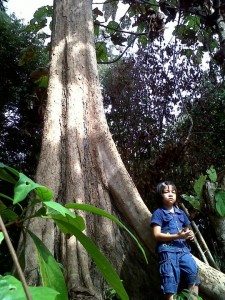 Benuaq girl and ncap payang tree
(c) EIA/Telapak Benuaq girl and ncap payang tree
(c) EIA/Telapak
.
Telapak president Ambrosius Ruwindrijarto said:
“Together with the community, we have not only been protecting the last forests but also planting new Ulin and Meranti saplings to enhance it. These people are the true guardians of the forest and their fate is entwined with it.”
Muara Tae has lost more than half of its land and forests during the past 20 years to mining companies. The impact has been tangible; the villagers’ water source has dried up and they must now routinely make a 1km journey to collect clean water.
The remaining forest is home to a large number of bird species including hornbills, the emblem of Borneo. There are about 20 species of reptiles and it is also a habitat for both proboscis monkeys and honey bears.
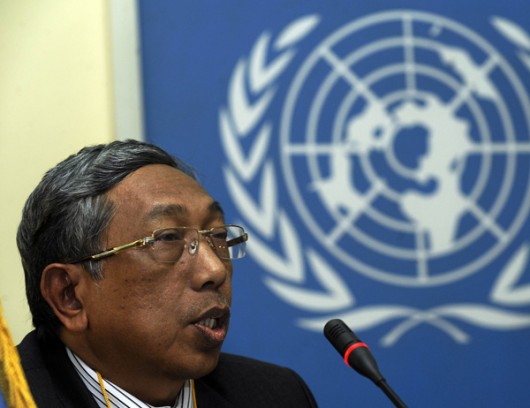 Indonesia’s Environment Minister Gusti Hatta,
all talk..so…’what does an Orang-Utan look like?‘
. Indonesia’s Environment Minister Gusti Hatta,
all talk..so…’what does an Orang-Utan look like?‘
.
The latest land-grabs have taken place since January 2010, when the local Bupati (regional government official), Ismail Thomas, issued plantation permits to two palm oil companies: Malaysian-owned PT Munte Waniq Jaya Perkasa (PT MWJP) and PT Borneo Surya Mining Jaya, a subsidiary of Sumatran logging, mining and plantation conglomerate Surya Dumai.
While the Norwegian Government has been instrumental in financially backing efforts to reduce deforestation in Indonesia through the REDD+ initiative, it has also invested in the parent company of PT MWJP through its sovereign wealth fund.
Pak Singko, a leader of the Dayak Benuaq of Muara Tae, said: “We are calling for help from people everywhere in protecting our forests and ancestral land. We are being squeezed from all sides by mining and plantation companies.
.
“This is the last remaining forests that we have and the only land we have to survive.
If my forests are gone, our lives will end.”
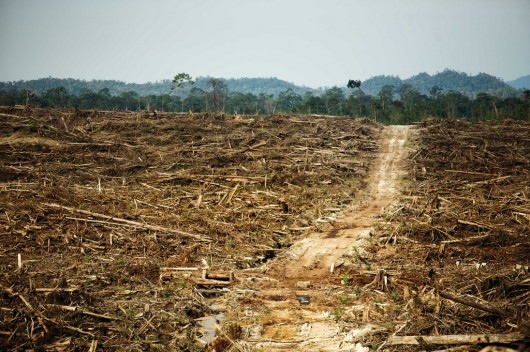 Cargill’s ecological facism for its self-serving Palm Oil
The destruction of primary rainforest by Duta Palma. West Kalimantan, Borneo.
Cargill was a key purchaser of palm oil from this notorious rainforest destroyer up until 2008. Cargill’s ecological facism for its self-serving Palm Oil
The destruction of primary rainforest by Duta Palma. West Kalimantan, Borneo.
Cargill was a key purchaser of palm oil from this notorious rainforest destroyer up until 2008.
[Source: Photo: David Gilbert/RAN, ^http://www.flickr.com/photos/rainforestactionnetwork/5551935164/]
(Click photo to enlarge)
.
The above photo is from an investigative report from Rainforest Action Network that presents evidence that (US conglomerate) Cargill is operating two undisclosed palm oil plantations in West Kalimantan, Indonesia.
 Cargill’s pathetic claim of its Corporate Responsibility in Indonesia Cargill’s pathetic claim of its Corporate Responsibility in Indonesia
[Source: Cargill corporate website: ^http://www.cargill.com.au/en/index.jsp].
.
When William Wallace Cargill founded our company in 1865, he deliberately set out to ensure that we earned and maintained a reputation for integrity, which he saw as a key differentiator in those times.
Corporate responsibility is part of everything we do. It is a company-wide commitment to apply our global knowledge and experience to help meet complex economic, environmental and social challenges wherever we do business. It is a process of continually improving our standards, our actions and our processes. Corporate responsibility extends not only to our own operations but to our wider communities and is based on four commitments:
- We will conduct our business with high levels of integrity, accountability and responsibility.
- We will develop ways of reducing our environmental impact and help conserve natural resources.
- We will treat people with dignity and respect.
- We will invest in and engage with communities where we live and work.
We recognize our continued success depends on the growth and health of our communities and partners, as well as the vitality and conservation of our natural resources. We are working with a diverse group of global, national and local organizations to support responsible economic development, help protect the environment and improve communities.
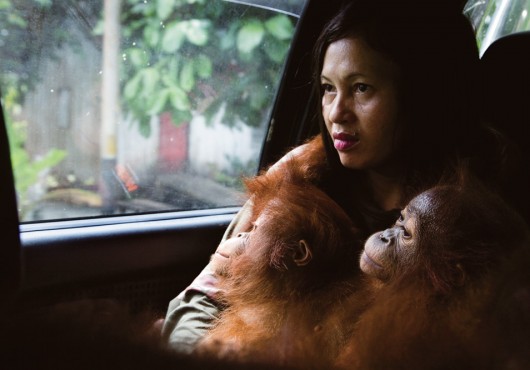 Forced eviction, forced immigration
Orang-Utan orphans fleeing their ravaged parents and their ravaged ancestral homes
Forced eviction, forced immigration
Orang-Utan orphans fleeing their ravaged parents and their ravaged ancestral homes
Present us an American citizen accepting of such home eviction!
.
ED: Cargill’s eco-rape and eco-plunder policy across Indonesia’s vulnerable Borneo (Kalimantan) demonstrates that Cargill’s above public relations spiel is clearly crap! This is a wealthy United States corporate exploiting a poor country’s precious rainforest ecosystems, buggering local indigenous peoples and driving the extinction of the endangered Orang-Utan. If you work for Cargill or have shares in Cargill yoiu may as well be associated with the arms suppliers to the Syrian president Bashar al-Assad and his regime.
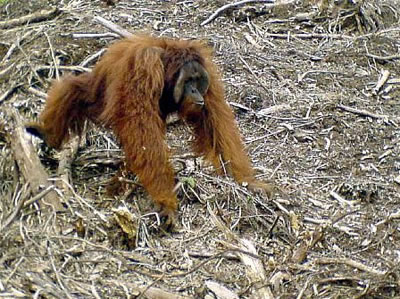 Not just home invasion, but complete ecological erasion
Cargill is calling in the A-Bomb to Orang-Utans
What United States citizen would tolerate this?
911 is being inflicted on vulnerable species by the United States Not just home invasion, but complete ecological erasion
Cargill is calling in the A-Bomb to Orang-Utans
What United States citizen would tolerate this?
911 is being inflicted on vulnerable species by the United States
.
.
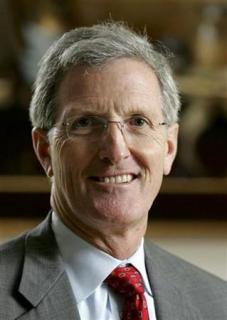 Cargill’s worldwide president and COO Gregory R. Page
His life won’t end in devastation, but he drives devastation in vulnerable Kalimantan – in secret! Cargill’s worldwide president and COO Gregory R. Page
His life won’t end in devastation, but he drives devastation in vulnerable Kalimantan – in secret!
.
Further Reading:
.
[1] ‘Villagers face off against palm oil firm’s bulldozers‘, by EIA, 20111123, ^http://www.eia-international.org/villagers-face-off-against-palm-oil-firms-bulldozers
.
[2] ‘Orangutan ‘killers’ on trial over slaughtering primates for pest control at palm oil plantation‘, by Damien Gayle, Daily Mail, 20120208, ^http://www.dailymail.co.uk/news/article-2097946/Orangutan-killers-trial-slaughtering-primates-pest-control-palm-oil-plantation.html
.
Tags: ancient rainforest, Cargill, deforestation, deforestation in Indonesia, EIA, Environmental Investigation Agency, forest exploitation, Gregory R. Page, Gusti Hatta, Hillary Clinton, Indonesia, Indonesian palm oil plantations, Kalimantan, Logging, logging Borneo, Meranti, Murara Tae, orang-utan, palm oil, palm oil plantations, payang tree, President of Indonesia, PT Borneo Surya Mining Jaya, PT Munte Waniq Jaya Perkasa, Sumatran logging, Surya Dumai, Susilo Bambang Yudhoyono, Telapak, Ulin, United States
Posted in Kalimantan (ID), Orang-utans, Threats from Farming | No Comments »
Add this post to Del.icio.us - Digg
Saturday, January 7th, 2012
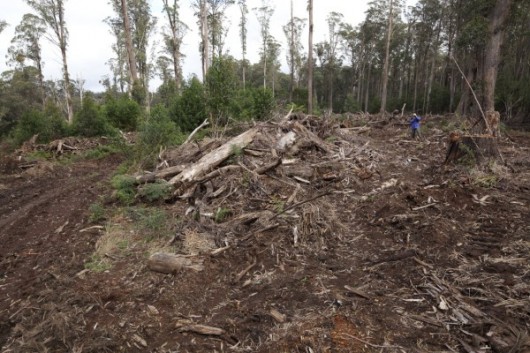 Cathcart State Forest (NSW) being logged in 2011
[Source: Australian Forests and Climate Alliance ^http://forestsandclimate.net/newsouthwales] Cathcart State Forest (NSW) being logged in 2011
[Source: Australian Forests and Climate Alliance ^http://forestsandclimate.net/newsouthwales]
.
Most of Australia’s native vegetation cover, over 75% of that predating the 1788 Colonial Invasion, has been ‘cleared’ – a euphemism for deforested, logged, destroyed, killed.
Today, as one travels around Australia and sees vasts areas of unproductive, degraded, denuded and abandoned farmlands – one questions why destroy more fragile environment? Yet the exploitative bastards are still hell bent on killing more native forest and bushland, even though they can’t properly manage the ‘already ‘cleared’ lands they’ve got. It is a short sighted insatiability, harking to a 19th Century ‘old blighty’ mindset of taming the land. It is deluded thinking that just because the native vegetation is green and looks fertile that it can be replaced for pasture and cropping and that new cleared land will be any different to that already cleared.
The Liberal-Labor governments and their rural National mates haven’t given a toss throughout the entire 20th Century and still couldn’t give a toss.
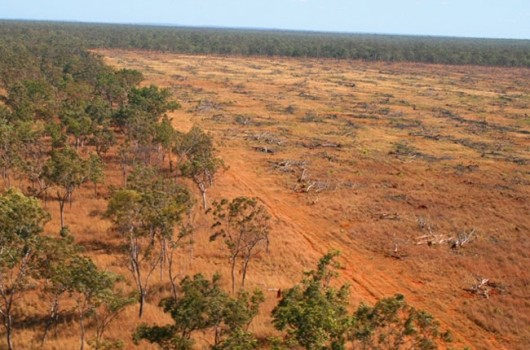 Recent land clearing in the Daly River catchment area
Northern Territory, Australia.
Photo: Environment Centre NT Recent land clearing in the Daly River catchment area
Northern Territory, Australia.
Photo: Environment Centre NT
.
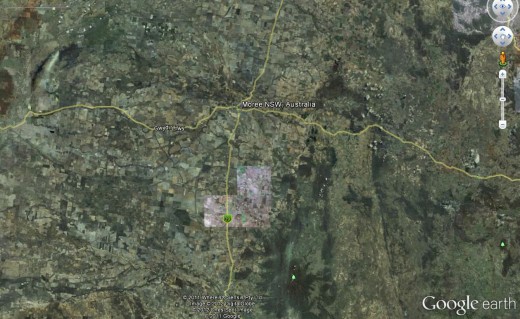 Moree region New South Wales – mainly deforested
Visit Google Earth and zoom into any area of NSW and see that most of it has been deforested
(click image to enlarge) Moree region New South Wales – mainly deforested
Visit Google Earth and zoom into any area of NSW and see that most of it has been deforested
(click image to enlarge)
.
Still across Australia in 2011, thousands of hectares of native forests continue to be deforested – albeit for farming, logging and development, or just bizarre bushfire abandonment. Not only is this occurring on private land, but in State Forests, which most people think are protected. Native forests on land are being cleared branded by State governments as ‘State Forests’ are simply not protected.
The native trees, flora and fauna are not protected from logging, bushfire, State-sanctioned arson (aka ‘hazard reduction‘), State napalming (aka indiscriminate ‘hazard reduction‘), indiscriminate State aerial poisoning with 1080, wildlife poaching, 4WD hooning, trail bike hooning, or even backpacker murdering. The watercourses (and the interconnected groundwater aquifers), that flow through State Forests are not protected from fishing, stormwater run-off, mine tailing contamination, farm pesticide and herbicide, industrial pollution.
.
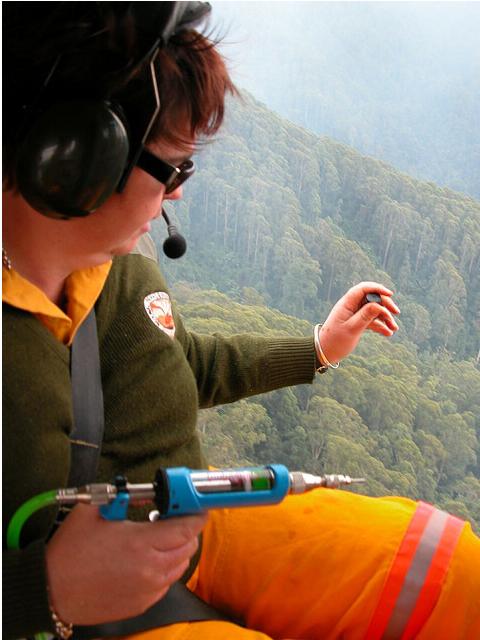 Helicopter Aerial Incendiary
Over Bindarri National Park, 20km south-west of Coffs Harbour, New South Wales
Yes, even our National Parks and Wildlife Service sets indiscriminate fires to National Parks! Helicopter Aerial Incendiary
Over Bindarri National Park, 20km south-west of Coffs Harbour, New South Wales
Yes, even our National Parks and Wildlife Service sets indiscriminate fires to National Parks!
.
For the likes of taxpayer funded government industrial loggers ‘State Forest’ is a euphemism ‘for not logged yet‘. This applies to the likes of Forestry Tasmania, VicForests, Forests NSW, Forestry SA (spot the naming trend), as well as the more aptly Queensland Department of Primary Industries and Fisheries, and likewise the Forest Products Commission of Western Australia.
It seems that doesn’t matter whether there is proof that there is an endangered and protected species such as the Long-Footed Potoroo in the Cann Valley State Forest or Drummer State Forest in Victoria, or protected Koalas in the Murrah/Mumbulla State Forests of New South Wales, or three identified endangered species, the wedge-tailed eagle, the swift parrot and the wielangta stag beetle in Tasmania’s Wielangta State Forests, the Liberal-Labor governments of those States turn a blind eye to deforestation.
It is only when self-funded local communities take the respective government logger to the Supreme Court and win that logging stops momentarily, such as in the recent Victorian Supreme Court case Environment East Gippsland Inc v VicForests [2010] VSC 335. In 2006, the Victorian State Government committed to increasing the conservation parks and reserves within the broader Brown Mountain area. Disregarding its elected master and ignoring any concerns for the ecological Precautionary Principle, State industrial logger VicForests, got stuck in with its mechanical clearfelling of old growth forests in the Brown Mountain area.
Not-for profit group Environment East Gippsland (EEG) self-funded and obtained numerous studies of the area indicated the presence of important threatened and rare species. EEG requested the Minister for Environment and Climate Change, Gavin Jennings, to make an interim conservation order to conserve critical habitat of the endangered Long-footed Potoroo, Spotted-tailed Quoll, Sooty Owl, Powerful Owl and Orbost Spiny Crayfish at Brown Mountain. Even then, the Minister for Environment and Climate Chang did not grant a conservation order, but instead increased the conservation area surrounding Brown Mountain. It took the overriding legal authority of the Supreme Court to stop the Victorian Government and its delinquent logger trashing protected old growth habitat.
 Victorian Labor Minister for Environment (etc), 2007-2010 Victorian Labor Minister for Environment (etc), 2007-2010
.
In March 2010, Forests NSW began controversial logging operations in the Mumbulla State Forest, south of Bermagui on the state’s far south coast. Despite being criticised, after a recent survey identified the forest as a key colony for the region’s remaining koala population, Forests NSW Regional Manager Ian Barnes says the logging must go ahead across 240 hectares of the forest, in order to satisfy a supply agreement with the timber industry.
 Deforestation is all about lining ones pockets out of ecological wanton exploitation
It’s a ‘wam bam thank you mam’ approach no different to what the Vikings did to the British in the eight Century.
Colonial Australians and their descendants are doing the same to Australian ecology in the 19th, 20th and 21st Centuries. Deforestation is all about lining ones pockets out of ecological wanton exploitation
It’s a ‘wam bam thank you mam’ approach no different to what the Vikings did to the British in the eight Century.
Colonial Australians and their descendants are doing the same to Australian ecology in the 19th, 20th and 21st Centuries.
Mr Barnes says the logging will not affect the koala habitat. “We’ve taken quite some effort to avoid any possible conflict there,” he says. “As anybody who reads the recent report will know, the koalas have been found in the eastern side of the forest, and our logging is planned for the western part, as far away as we can get from the koalas.”
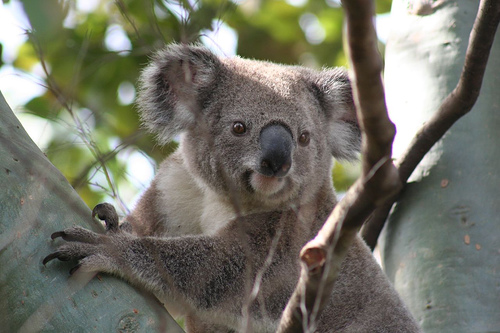
Despite assurances, anti-logging campaigners have organised a vigil in the forest in an attempt to stop the logging. Conservationist Prue Acton says the activity will devastate the koala population.
“Why risk the only healthy koala colony left in the far south coast. For what? “ she said. “95% of what is going to be logged is going to end up at the Eden woodchip mill, be shipped to Japan for cheap copy-paper. What a disgrace.”
The Greens MP Lee Rhiannon says the Premier should put the protection of koalas ahead of the interests of logging companies. “The New South Wales Government has refused to end logging in the south east native forest but they should step in and stop the destruction of the koala habitat,” she said.
[Source: ‘Logging begins near key koala habitat‘, ABC, 20100330, ^http://www.abc.net.au/news/stories/2010/03/30/2859615.htm?site=southeastnsw]
.
‘Loggers are clearing bushland at rising rate‘
[Source: ‘Loggers are clearing bushland at rising rate’, by Ben Cubby, Sydney Morning Herald, 20111221, ^http://www.theherald.com.au/news/national/national/general/loggers-are-clearing-bushland-at-rising-rate/2399764.aspx?storypage=0]

The amount of bushland being cleared by logging in NSW soared last year to the highest level since state-wide records began in 1988. An area equivalent to 138,400 football fields was cleared for crops, forestry or infrastructure, says a government report.
The Office of Environment and Heritage said the rise in logging was probably cancelled out by regrowth, leading to no net loss of trees, though its most recent survey took place in 2008, before the land clearing spike. It said the reasons for the logging increase were unclear.
”[The] most likely factors relate to market demand and favourable climatic conditions and [they] can be expected to fluctuate over time,” a department spokesman said. ”It is also possible that recent changes in forestry methods are more readily detectable by satellite monitoring.”
Environment groups said the annual vegetation report was evidence that logging companies were operating in an unrestrained manner.
Bushfires remain the biggest destroyer of forests in the state, leading to a net loss of 48,300 hectares in 2010, the report said.
.
But logging activities now come a close second, accounting for the removal of 42,700 hectares of trees in 2010. This is up from 31,000 hectares the previous year, and an average of about 21,000 hectares a year since 1988.
About 21,200 hectares of bushland was cleared in 2010 to make new areas for crops and grazing, while 5300 hectares were cut down to make way for roads, factories and housing.
”The NSW government is currently conducting a review of native vegetation controls,” said the chief executive of the Nature Conservation Council of NSW, Pepe Clarke. ”They should take this report as a warning – what is required are stronger land- clearing laws that do more to protect the environment, not weaker ones.”
The Wilderness Society said the government had ”failed in its promises to restrain land clearing, resulting in rapid and accelerating degradation of wildlife habitat and water catchments.”
The most recent State of the Environment report found that there had been no net loss of ”woody cover” across NSW between 2003 and 2008.
”This is because, although clearing has occurred over that period, there has also been an equivalent amount of regrowth including government sponsored environmental and forestry planting programs conducted by private landholders and state forests, within crown forests areas,” the department said.
”Notwithstanding no net loss over the whole state, some regions have experienced net declines in woody cover.”
The report uses the international definition of ”woody cover”, which includes land at least 20% covered by the crowns of trees higher than 2 metres, a description which would include relatively open country.
The introduction of a satellite monitoring system for land clearing last year appears to have increased the level of prosecution for illegal land clearing on private property. On crown lands, the number of prosecutions has increased threefold, from a low base, since 2007.
In 2010, the government received 471 reports of suspected illegal land clearing.
.
‘Landowners sent satellite images identifying land clearing‘
[Source: ‘Landowners sent satellite images identifying land-clearing’, NSW Department of Environment (etc), Media release: 14 May 2010, ^http://www.environment.nsw.gov.au/media/DecMedia10051404.htm]
.
NSW Department of Environment Climate Change and Water (DECCW) today began a high tech education campaign to encourage compliance with native vegetation laws by sending letters to landholders including before and after satellite pictures identifying land clearing.
DECCW Director-General Lisa Corbyn said the letters were part of an ongoing education program to encourage compliance with the laws and inform landowners of the proper channels available to them if they want to clear native vegetation.
“We’ve been using satellite technology for some time to identify changes in vegetation cover that may warrant further investigation,” Ms Corbyn said.
“Now we are also using the technology as an education tool. From today, advisory letters will be sent to landowners including before and after satellite pictures showing that vegetation has been cleared on their land.”
Ms Corbyn said the letters aim to inform to the landowner that the satellite imagery has picked up that vegetation had been cleared and highlight the proper channels available to them under the legislation to allow clearing of native vegetation, such as property vegetation plans.
The letters support other tools used by DECCW to encourage compliance with the legislation, including strategic investigations, prosecutions, penalty notices, stop work orders, remedial directions, warning and advisory letters.
The letter also alerts landowners to incentive funding available to restore and protect native vegetation on their properties.
The Native Vegetation Act was introduced in 2003 to bring an end to broadscale land-clearing in NSW. Since then, more than 400,000 hectares of native vegetation has been conserved or rehabilitated on private land through property vegetation plans (PVPs) and 1.6 million hectares has been managed for thinning and invasive native scrub management.
.
Over 60 % of the native vegetation in NSW has been cleared, thinned or substantially disturbed.
.
The impacts of native vegetation clearing have included the extinction of 77 plant and animal species, soil erosion, increased dryland salinity and a decline in water quality.’
.
2003: ‘Clearing rate in NSW 116,000 to 216,000 hectares per year: NSW Govt report’
[Source: ‘Clearing rate in NSW 116,000 to 216,000 hectares per year: NSW Govt report’, by Stephanie Peatling, Environment Reporter, Sydney Morning Herald, 20031117, ^http://www.sydneyalternativemedia.com/id64.html]
.
The equivalent of up to 200,000 football fields may be illegally stripped of native trees and grass each year in NSW, figures suggest.
The first estimates on the extent of the clearings, which the Department of Natural Resources field staff prepared for the Government’s vegetation taskforce, suggest the figure could be as high as 100,000 hectares a year. The figures show between 150,000 hectares and 560,000 hectares were illegally cleared between 1997 and 2002.
The advice is the first official guess at NSW’s illegal clearance levels. The highest rates are in the Barwon, Central West and Far West regions where much of NSW’s remaining native vegetation is located.
The figures have shocked environmentalists, who stress the urgency of making changes to the state’s natural resource management system, which Parliament is debating this week.
A Wilderness Society campaigner, Francesca Andreoni, said: “The new system needs to be fair to everyone, particularly farmers doing the right thing.
“The shocking extent of illegal clearing confirms the urgent need for the Government to implement its decision to end broadscale clearing.”
Figures recording the rate of illegal land clearing each year are almost impossible to compile because it so hard to charge people who breach native vegetation laws. There is also a complicated system of exemptions which allow people to clear land for purposes such as maintaining fire access trails.
Monitoring illegal clearing is potentially dangerous for departmental compliance officers. After reports of illegal clearing earlier this year on a property near Nyngan, in the state’s west, department officers were prevented from entering the property by an angry crowd of up to 150 people.
.
When the amount of land illegally cleared is added to land that is legally approved for clearance, the department estimates between 700,000 hectares and 1.3 million hectares of land were cleared between 1997 and 2002.
.
The figures suggest clearing was faster than the Department of Natural Resources’ previously admitted figure of about 60,000 hectares a year. That figure would give NSW the second-highest clearing rate in the country behind Queensland.
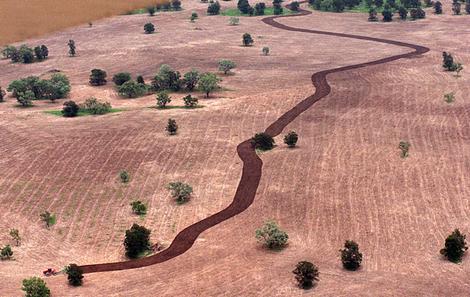
Debate on the Government’s package to overhaul native vegetation laws, based on an election promise to end broad-scale clearing, will take place this week. Last month the Premier, Bob Carr, announced a $406 million deal between farmers and environmentalists to end broad-scale clearing.
Most of the money is expected to go towards such things as tree planting and fencing waterways to help counter salinity and erosion. But local authorities may also compensate farmers for not clearing land. Clearing will still be allowed where it is deemed environmentally necessary.
Under the new system, natural resource management is being overhauled. Thirteen catchment management authorities will replace 19 catchment management boards, 20 regional vegetation committees and 33 water management committees.
Scientists often name land clearing as one of Australia’s most urgent environmental concerns. It contributes to soil salinity, loss of biodiversity and greenhouse gas emissions because carbon dioxide is released into the atmosphere when the cleared timber is disposed of, usually through burning.
.
‘Green groups attack logging growth’
[Source: ‘Green groups attack logging growth’, by David Bancroft, My Daily News, 20111229, ^http://www.mydailynews.com.au/story/2011/12/29/green-groups-attack-logging-growth/]
.
Environment groups have banded together to criticise the level of logging occurring in New South Wales. The Nature Conservation Council, The Wilderness Society, National Parks Association, the Northern Inland Council for the Environment and the North Coast Environment Council have issued a joint warning that iconic and endangered species are being threatened by land clearing.
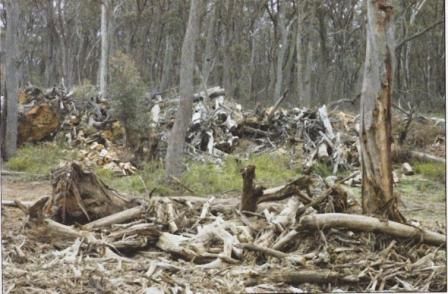 Illegal deforestation for fire wood, near Taralga, on the western edge of the Blue Mountains
Source: ^http://www.orchidsaustralia.com/article_%20conservation_no3.htm Illegal deforestation for fire wood, near Taralga, on the western edge of the Blue Mountains
Source: ^http://www.orchidsaustralia.com/article_%20conservation_no3.htm
.
In a joint press release, the groups said the NSW annual report on native vegetation released by the Office of Environment and Heritage (Ed. yet another money wasting name change) this month showed 2009/10 was the “worst year on record for clearing of native bushland”.
.
The Wilderness Society campaigns manager Belinda Fairbrother said the report showed that in 2009/10 an area equating to 138,400 football fields was cleared for crops, forestry or infrastructure.
.
“This is higher than any other year since records commenced in 1988 and shows the NSW Government has failed in its promises to restrain land clearing, resulting in rapid and accelerating degradation of wildlife habitat and water catchments,” she said.
North Coast Environment Council president Susie Russell said the report made a sad end to the International Year of Forests.
“The area cleared for forestry in 2009/10 was almost five times greater than it was in 1988/89,” she said.
“It reveals a massive increase in the rate and intensity of logging in NSW, which will be causing untold damage to the extraordinary high diversity forests of north-east NSW.”
Nature Conservation Council chief executive officer Pepe Clarke said land clearing was recognised as the single greatest threat to wildlife in Australia.
“It causes the death of birds and animals, the extinction of species, leads to the poisoning of soils from salinity and makes a major contribution to global warming,” he said.
.
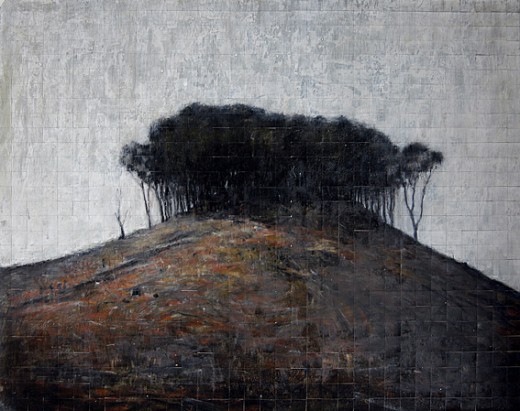 The Liberal-Labor Party ‘Island Vision’ for Australia’s State Forests
‘The Hill’ (Penrose State Forest, NSW) 2007, drawing by James King The Liberal-Labor Party ‘Island Vision’ for Australia’s State Forests
‘The Hill’ (Penrose State Forest, NSW) 2007, drawing by James King
^http://www.jamesking.com.au/drawings.html
.
Tags: 1788 Colonial Invasion, Cathcart State Forest, deforestation, Eden woodchip mill, fire wood, Forests NSW, Google Earth, hazard reduction, Helicopter Aerial Incendiary, Island Vision for Australian State Forests, koala habitat, land clearing, Logging, Long-footed Potoroo, Murrah/Mumbulla State Forests, not logged yet, Orbost Spiny Crayfish, Powerful Owl, precautionary principle, Sooty Owl, spotted-tailed quoll, State-sanctioned Arson, VicForests, Wielangta State Forests
Posted in Koalas, Owls, Quolls, Threats from Bushfire, Threats from Deforestation, Threats from Farming | No Comments »
Add this post to Del.icio.us - Digg
Friday, December 30th, 2011
What area of old growth native forest has been saved from business-as-usual deforestation as a result of the United Nation’s declaration of 2011 as the International Year of Forests?
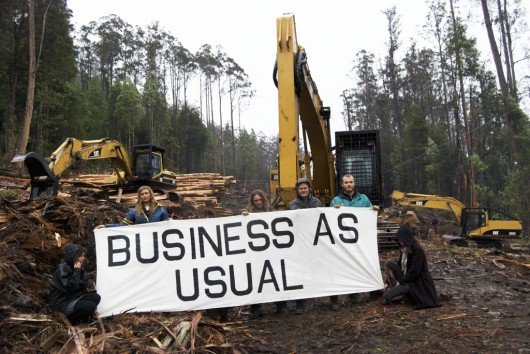 In Tasmania frankly it’s been logging Business-as-Usual
for taxpayer-funded ‘Forestry Tasmania’
(Source: Still Wild Still Threatened,
^http://observertree.org/2011/12/22/mirandas-daily-blog-day-8/) In Tasmania frankly it’s been logging Business-as-Usual
for taxpayer-funded ‘Forestry Tasmania’
(Source: Still Wild Still Threatened,
^http://observertree.org/2011/12/22/mirandas-daily-blog-day-8/)
.
UN International Year of Forests 2011 – ‘Global Objectives‘?

This is (was) the official UN website: ^http://www.un.org/en/events/iyof2011/
.
Well, at the time of writing, the public relations material on the official UN website conveys a general message that the ‘Forests 2011‘ programme is intended “to strengthen global efforts to improve the state of forests” and draws upon its dedicated subsidiary United Nations Forum on Forests (UNFF), adopting four Global Objectives:
- Reverse Forest Loss – reverse the loss of forest cover worldwide through sustainable forest management, including protection,restoration, afforestation and reforestation, and increase efforts to prevent forest degradation.
- Enhance Forest-based Benefits – economic, social and environmental benefits, including by improving the livelihoods of forest-dependent people.
- Increase Sustainably Managed Forests – including protected forests, and increase the proportion of forest products derived from sustainably managed forests.
- Mobilize Financial Resources – reverse the decline in official development assistance for sustainable forest management and mobilise significantly-increased new and additional financial resources from all sources for the implementation of sustainable forest management.
.
[Source: ^ http://www.un.org/en/events/iyof2011/forests-for-people/global-objectives/]
.
Sounds encouraging, but where are the stated deliverables?, key result areas?, key performance indicators?, programme targets?, UN budget to achieve these global objectives? Where is the implementation plan and the delegated implementation task force?
The website is thick on its public relations message, but thin on substance. In the absence of any mention of the means to achieve these four objectives, my initial reaction is that it is more motherhood and perhaps just about ‘raising awareness‘. But don’t we already know that deforestation is a critical global problem?
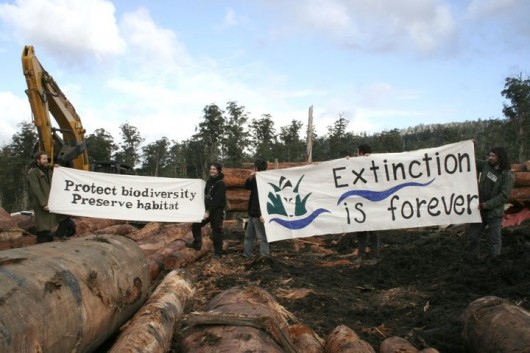
.
The aim of the UN International Year of Forests 2011 seems to have merely been “to raise awareness and strengthen the sustainable management, conservation and sustainable development of all types of forests for the benefit of current and future generations“.
.
It just sounds like more Forestry spin!
.
And ‘sustainable forest management‘ is a familiar phrase and one bandied about not by environmentalists, but by forestry industry – i.e. industrial loggers. Type ‘sustainable forest management’ in Google at look at the websites results:
- Australian Government Department of Agriculture, Fisheries and Forestry (i.e. derives revenue from logging)
- Australian Forest Education Alliance (AFEA) – includes members from Australian Forest Products Association, Forests NSW, Forest Education Foundation Tasmania, Forest and Wood Products Australia, Primary Industries and Resources South Australia, Forestry Sustainable Forestry Program (Southern Cross University), NSW Forest Products Commission WA, VicForests (i.e. all derive revenue directly from logging, or subsidised by industrial loggers)
- Forestry Tasmania (i.e. derives revenue from logging)
- Forests NSW (i.e. derives revenue from logging)
- Food and Agriculture Organisation of the United Nations (encouraged forest be used for wood production)
- The Institute of Foresters of Australia
- Department of Sustainability and Environment (Victoria) (encouraged logging and burning of native forests)
- etc.
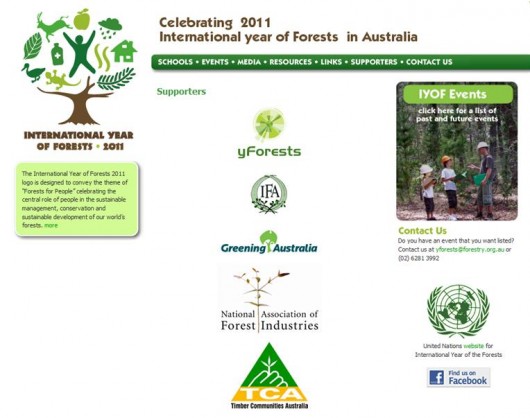
.
UN International Year of Forests 2011 – ‘Global Achievements‘?
.
The only other information that may be gleaned from the official UN site covers topics such as promotional events, films, photos, collaborative global partner organisations plus some forest statistics, a few online publications but that’s about it. So today on 30th December 2011 as the International Year for Forests draws to a close, what has the UN programme actually achieved?
What area of the world’s native forests has been protected from otherwise business-as-usual deforestation? What has stopped Forestry Tasmania and its band of loggers from their business-as-usual holocaust treatment of Tasmania’s endangered ancient native forest ecosystems?
Answer: More PR funding for the UN’s next programme?
.
Australian Government’s endorsement of International Year of Forests 2011
.
Rather than convey an assessment here, I shall just quote from the Australian Government’s website dedicated to supporting this programme (before it vanishes):
.
[Source: ^ http://www.internationalyearofforests.com.au/]
.
Australia’s Forests
.
‘Australia has some of the most beautiful and productive forest areas in the whole world. These fantastic and magical places mean a lot of different things to different people. Some of us work with the wood from the forests. Some work with the creatures that live in the forests. Some of us live in the forests and some of us play in the forest (camping, hiking, exploring) and some of us just love looking and being in a forest!
‘Without a doubt what ever your use, be it a little or a lot, Australian’s should be proud of Australia’s forests!
‘The United Nations announced 2011 as the International Year of Forests. Australians can unite and celebrate our sustainably managed forests and the diversity that our forests bring to our lives. Our forests give us wood that we use every single day and these very same forests give us the best playground that our kids could ever hope for. Australia’s forests are used by everyone and are the best in the world!
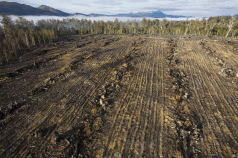
.
Ministers Address
.
‘Australia has about 4 per cent of the world’s forests on 5 per cent of the world’s land area, and has one of the best managed forestry sectors in the world.
‘The nation’s forests, and the products they produce, provide significant employment, environmental and recreational benefits to communities across Australia. Australia’s forestry and wood manufacturing sector employs nearly 76,000 people, many in regional areas, and generates around $7 billion worth of wood and paper products annually.
‘Across the nation the forests in conservation reserves cover over 23 million hectares. These reserves provide recreational benefits for communities and contribute to the 12 billion tonnes of carbon stored by Australian forests. Industry and government have been working hard to make sure our forests remain sustainable and viable for the long-term.
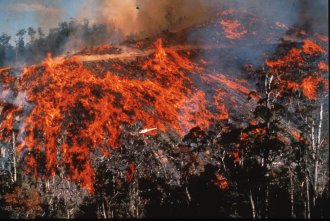
‘The Australian Government recognise the importance of World Forestry Day and the International Year of Forests and has actively supported both initiatives. This year the Gillard Government intends to release legislation to ban the importation of timber products that have not been legally harvested. This law will contribute to global efforts to stop illegal logging, provide for sustainable forest products made in Australia and reduce unfair competition. The Gillard Government remains committed to promoting sustainable forestry initiatives and encourages people to celebrate the International Year of the Forest.’
Senator Joe Ludwig,
Minister for Agriculture, Fisheries and Forestry
.
And guess who’s embraced the 2011 International Year of Forests with public relations relish?
.
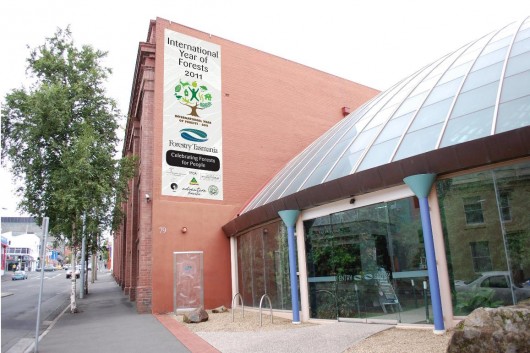 Forestry Tasmania Forestry Tasmania
“Congratulations to Forestry Tasmania (FT) who held a successful Tasmanian launch of International Year of Forests. Held in Hobart on 25 January the ‘forest in the city’ event proved to be a popular summer holiday diversion with a steady stream of families, shoppers and naturalist flowing in to the Melville Street Dome throughout the afternoon.”
.
[Source: ^http://www.internationalyearofforests.com.au/news.php]
.
.
‘International Year of Forests 2011 off and running in Tasmania’
.
[Source: Forestry Tasmania website, 20110131, ^http://www.forestrytas.com.au/news/2011/01/international-year-of-forests-2011-off-and-running-in-tasmania?utm_source=feedburner&utm_medium=feed&utm_campaign=Feed:+forestrytas+%28ForestryTas.com.au+News+and+Topics%29]
..
‘Forestry Tasmania (FT) kicked off its celebrations for the United Nations International Year of Forests 2011 with an open day at the ‘forest in the city’ in its Hobart headquarters on 25 January. The event proved to be a popular summer holiday diversion, with a steady stream of families, shoppers and naturalists flowing into the Melville Street Dome throughout the afternoon. Their curiosity was rewarded by science and fire fighting displays, indoor abseiling, and even the opportunity for the young (and young at heart) to have their photo taken with ‘Krusty’, FT’s very own giant freshwater crayfish.
 Forestry Tasmania’s promotional campaign for the International Year of Forests 2011
…to educate children early on that Forestry is good for native forests.
Tasmania’s endangered Giant Freshwater Crayfish just loves loggers destroying its habitat.
Get ’em while they’re young Bob! Forestry Tasmania’s promotional campaign for the International Year of Forests 2011
…to educate children early on that Forestry is good for native forests.
Tasmania’s endangered Giant Freshwater Crayfish just loves loggers destroying its habitat.
Get ’em while they’re young Bob!
.
Forestry Tasmania’s General Manager Corporate Relations and Tourism, Ken Jeffreys, said the open day was just a taste of things to come, with a 12-month calendar of events planned to celebrate the International Year of Forests.
“We have a number of exciting projects scheduled over the next year, such as the opening of new accommodation at Tahune, to be called the AirWalk Lodge.
“This development will, for the first time, see family accommodation available at one of Tasmania’s most highly visited tourism attractions. It will allow our guests to spend a full day experiencing all of the activities on offer at the AirWalk, as well as the many other attractions on offer in the Huon Valley.
“The year will also see a number of high-profile sporting events on state forest, including mountain biking and the multi-sport Ben Lomond Descent.
“And one of our bursary recipients, Shannon Banks, is going to attempt to visit all 52 of our recreation and tourism attractions around the State over the year. She’ll be writing a blog about her adventures, which we hope will inspire Tasmanians to experience the wonders of the forests in their own backyard.”
.
Mr Jeffreys said FT’s staff were excited by the opportunities presented by the International Year of Forests 2011.
“This year, we want to show the community that we are proud of the work we do to ensure the full range of forest values are maintained in perpetuity. Our staff worked hard to create displays for the launch that were fun and informative. The public’s reception showed us that there is a great deal of interest, and open-mindedness, about the way our forests are managed.”
.
Speech notes Simon Grove (Conservation Biologist with Forestry Tasmania – Division of Forest Research & Development):
.
‘Before I hand over to Rebecca White MHA to officially launch the International Year of Forests, I’ve been asked to say a few words about what our forests mean to the people that work here in Forestry Tasmania. Since our values come from our personal life-experiences, all I can do is tell you my own story, while recognising that every one of us here has their own story too.
I work as a researcher, a conservation biologist, with Forestry Tasmania. In some ways I deal with the meat in the sandwich that is forestry today – what does nature have to say about how we manage – or should manage – the forests in our care? But I want to start at the beginning. Life is all about discovery, learning and figuring things out, and I was lucky to discover early in life that nature, and forests, can be an excellent source of inspiration and experimentation. So here are a few of my naturalists’ memories, going back to toddlerdom.
I remember:
- Figuring out that earthworms have bristles that work like legs – if you fill an empty milk-bottle with worms and then leave the milk-bottle in the kitchen, the worms climb out and slither all over the kitchen floor.
- Learning that if I sat very still in the woods, I could watch the native mice going about their lives – and I could even catch them in my hands – but that they would bite my little sister’s hands if she tried the same thing.
- Learning that bumblebees loved the nectar of honeysuckle flowers as much as I did – and that they wouldn’t sting if I picked them up to enjoy the sensation of having them buzzing around in my cupped hands – but that they would sting my little sister’s hands if she tried the same thing.
- Discovering that it wasn’t only nasty wasps that filled the summer air with their droning, but beautiful flower-loving hoverflies – but little sisters aren’t always good at telling them apart.
- Realising that hungry ground-beetles eat lizards if you keep them in the same cage and don’t feed them.
- Learning that baby starlings abandoned by their parents get too hot if you try and incubate them on the boiler.
- Discovering that tadpoles kept in a glass jar don’t turn into frogs unless you give them some land to climb out onto.
- Realising that flower-presses were designed for delicate plants such as dandelions, and not for cacti.
- Learning that seashells brought back from the beach get very smelly if they still have their animals in them.
- Discovering that puffball fungi give off clouds of spores if you wee on them.
- Discovering that blackbirds’ eggs taste as good as chooks’ eggs if you fry them up on a camping stove in the garden.
- Figuring out that foxes eat cherries – you can find the stones in their poos.
- Figuring out that I could make wonderfully whiffy stink-bomb mixture by adding all sorts of sordid ingredients – dog-poo, apple-cores, ink – to the liquid accumulating in the bottom of a tree-hollow; but that if I then added real chemical stink-bomb ingredients to this then I ended up with dead-maggot stew instead.
.
We all have stories like this. (Ed: perhaps only at FT) In retrospect, we can see that they make us who we are today. Our challenge is to ensure that the next generation is encouraged to explore and experiment too.
I didn’t grow up in Tasmania, but the other side of the world in England. But I don’t think it would have made much difference to my outlook as a child. Nature’s all around us, and children the world over are tuned into it. If it’s nurtured, as it was in me, the empathy for nature can grow. Otherwise it may die away. The presence here today of so many families and children is testament to the amount of nurturing going on around us – which is wonderful to see. And what better place to do so than in our forests.
Some of us are lucky in that as adults we still get to liberate our inner child from time to time – every day if we’re very lucky. That’s how I’ve managed to live my life since leaving school – right through the years of university study; of working with nature conservation organisations in the UK; of working in Uganda as a conservation trainer in the forest department and in Indonesia as a training adviser on an international sustainable forest management project. It’s how I lived my life when I was researching rainforest insects in North Queensland for my PhD. And it’s how I have done so for the past decade as a conservation biologist here at Forestry Tasmania.
And despite what you might expect from media coverage of forestry issues, I don’t feel alone. Many people working in forestry here in Tasmania are naturalists at heart, and many more who wouldn’t call themselves naturalists nevertheless have a deep appreciation for the bush and an understanding of what makes it tick. Not so much sawdust in our veins, as bushdust – an empathy with the forests, and a recognition that we humans are not so much their lords and masters as their stewards.
My brother and I used to call chainsaws ‘long bottoms’, because to my ear they sounded like someone doing a very long fart. Later in my youth I came to see them as the conservationist’s friend, as we went about clearing wildling pines invading the heathland where rare birds nested. Today I know that chainsaws also have more prosaic functions – people use them to harvest trees so that they can be turned into products that we all use, such as timber and paper. This would be a tragic end for the forest if harvest were indeed the end-point. But it’s not, because experience shows that the elements of nature displaced by the harvest begin to move straight back in almost as soon as the chainsaws fall silent, and the forest begins to regrow and to fill with life again.
A background in natural history is good for making connections – among species and among natural processes. We learn that eagles feed on pademelons that graze on grasses and browse on young saplings; eagles nest in the old trees that grew up after the last wildfire and that escaped the browsing of pademelons; fungi and beetles recycle the trees – and even the eagles and pademelons – once they die. Eagles, trees, fungi, pademelons and beetles are all connected. Those of us steeped in natural history and ecology also make connections between humans and the rest of nature. We’re the original environmentalists. We recognise that the world faces not only a GFC but also a GEC – a global environmental crisis. I should emphasise that this crisis is not the outcome of sustainable forestry. But it is the cumulative outcome of all of our growing material demands outstripping the planet’s ability to supply. We all – especially our children – have to deal with the consequences.
In this context, we still expect the world’s remaining forests to be reservoirs of nature and yet to continue to supply our material and spiritual needs. It’s a big ask, but it can be done – certainly so in a place like Tasmania, with all the expertise in forestry and conservation at our disposal.
If I’ve discovered one big theme about the natural world during my life, it is that nature, for all its fragility, is remarkably resilient – think how forests recover after a bushfire. And the main take-home message from the forestry Masters course that I took at Oxford all those years ago, reinforced by daily experience since then, is that forestry is as much about people as it is about trees. Connecting the two concepts I come to a heartening conclusion. Through the increasing value that all of us place on our forests, they look set to become landscapes not of conflict but of reconciliation. Let’s see if we can use this International Year of Forests to further that end.
I’d now like to formally hand over to Rebecca White MHA, so that she can officially launch this International Year of Forests as Forestry Tasmania’s Ambassador.’
.
(Tasmanian) State Labor Member for Lyons and International Year of Forests Ambassador, Rebecca White MP, was on hand to officially launch Forestry Tasmania’s celebrations for 2011. She said the UN’s theme for the year, ‘celebrating forests for people’, had struck a deep chord with her.
“This theme resonated deeply with me, as it conveys the need to manage forests for many values, including conservation and sustainable development. It means that these values, which are often portrayed as being in conflict, are in fact intertwined. It also recognises that people are central to the effective management of forests.
“With careful, scientifically driven management, such as we have in Tasmania, there need not be a contradiction between conserving biodiversity and providing wood products and other non-commercial values from forests.
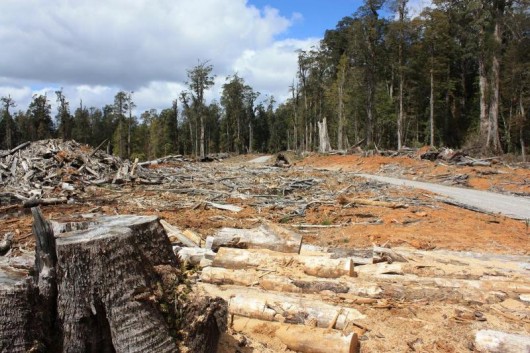 Forestry Holocaust of the Tarkine, October 2009
Forestry Holocaust of the Tarkine, October 2009
.
“While not all values may be delivered in any one area of forest, they are delivered across the entire landscape. While there are of course a number of challenges confronting the forest industry at present, it’s nonetheless important to remember that our state forests provide skilled employment for thousands of Tasmanians, and indirect employment for many more in our rural and regional communities.
“And of course, our state forests also provide clean drinking water to our towns and cities, they store the equivalent of 24% of Tasmania’s carbon emissions each year, and they provide a host of recreation activities and tourism attractions that appeal to locals and visitors alike.”
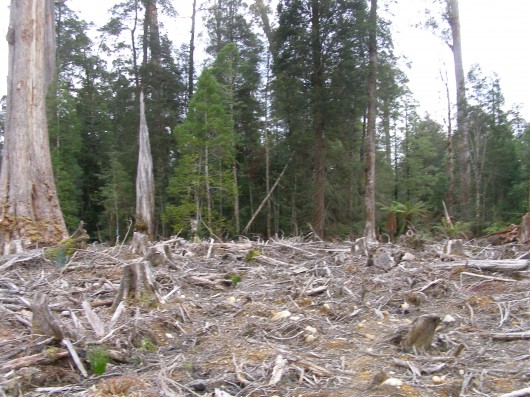 Upper Florentine old growth forest clearfelled by Forestry Tasmania in 2009,
situated behind Forest Defenders’ Camp Flozza
(Photo by Editor 20110928, free in public domain, click to enlarge) Upper Florentine old growth forest clearfelled by Forestry Tasmania in 2009,
situated behind Forest Defenders’ Camp Flozza
(Photo by Editor 20110928, free in public domain, click to enlarge)
.
World Deforestation Clock
.
- Each year about 13 million hectares of the world’s forests are lost due to deforestation, but the rate of net forest loss is slowing down, thanks to new planting and natural expansion of existing forests.
- From 1990 to 2000, the net forest loss was 8.9 million hectares per year.
- From 2000 to 2005, the net forest loss was 7.3 million hectares per year – an area the size of Sierra Leone or Panama and equivalent to 200 km2 per day.
- Primary forests are lost or modified at a rate of 6 million hectares per year through deforestation or selective logging.
- Plantation forests are established at a rate of 2.8 million hectares per year.
.
NOTE: 13,000,000 hectares/year = .412 hectares/sec
[Source of statistics: FAO Forest Resources Assessment 2005]
See the World Deforestation Clock at http://www.cifor.org/defclock.
.
Tags: clearfell, Corporate Relations, Forestry Holocaust, Forestry spin, Forestry Tasmania, giant freshwater crayfish, Logging, logging business as usual, sustainable forest management, tarkine, UN International Year of Forests, UN International Year of Forests 2011, United Nations Forum on Forests, Upper Florentine Forest, Upper Florentine Valley
Posted in Tasmania (AU), Threats from Deforestation, Threats from Greenwashing, Threats to Wild Tasmania | No Comments »
Add this post to Del.icio.us - Digg
|
|
 Terania Creek
Toward Nightcap National Park, part of the Gondwana Rainforests of Australia World Heritage Area,
Northern Rivers Region, New South Wales, Australia.
‘Terania‘ is thought to be a local Aboriginal (Bundjalung) name meaning ‘place of frogs’.
[Click image to enlarge, photo by Editor 20131023, © under ^Creative Commons]
Terania Creek
Toward Nightcap National Park, part of the Gondwana Rainforests of Australia World Heritage Area,
Northern Rivers Region, New South Wales, Australia.
‘Terania‘ is thought to be a local Aboriginal (Bundjalung) name meaning ‘place of frogs’.
[Click image to enlarge, photo by Editor 20131023, © under ^Creative Commons]
 Community direct action protest against logging at Terania Creek in 1979
This black and white photo by David Kemp (1979) is part of a faded pictorial history montage behind glass in a National Parks visitor noticeboard located at Protesters Falls car park, alongside Terania Creek. The image of the original photo has fault in that it includes reflection from the glass showing a yellow van at the car park, not in 1979 but in 2013. We happily walked along the board walk to Protesters Falls, passing by we assume the van’s owner happily bent backwards meditating on a large beach ball within the shaded tranquillity of the very tall rainforest. Unawares, he has inspired the writing of this article.
[Click image to enlarge, photo by Editor 20131023, © under ^Creative Commons]
Community direct action protest against logging at Terania Creek in 1979
This black and white photo by David Kemp (1979) is part of a faded pictorial history montage behind glass in a National Parks visitor noticeboard located at Protesters Falls car park, alongside Terania Creek. The image of the original photo has fault in that it includes reflection from the glass showing a yellow van at the car park, not in 1979 but in 2013. We happily walked along the board walk to Protesters Falls, passing by we assume the van’s owner happily bent backwards meditating on a large beach ball within the shaded tranquillity of the very tall rainforest. Unawares, he has inspired the writing of this article.
[Click image to enlarge, photo by Editor 20131023, © under ^Creative Commons]
 Find Out More: ^http://nigelturvey.com/page1001.aspx
Find Out More: ^http://nigelturvey.com/page1001.aspx Local resident Neil Pike (left) being dragged away from the protest site by police down Mackay’s Road 17th August 1979
[© Photo by Darcy McFadden, The Northern Star (newspaper) photographer].
Local resident Neil Pike (left) being dragged away from the protest site by police down Mackay’s Road 17th August 1979
[© Photo by Darcy McFadden, The Northern Star (newspaper) photographer].

 The National Parks Sign with appropriate graffiti-etched message.
A poignant reminder that Nightcap National Park came about only because of Community Direct Action.
[Photo by Editor 20131023 in Nightcap NationalPark, © under ^Creative Commons]
The National Parks Sign with appropriate graffiti-etched message.
A poignant reminder that Nightcap National Park came about only because of Community Direct Action.
[Photo by Editor 20131023 in Nightcap NationalPark, © under ^Creative Commons]
 “tangle of creepers as thick as a forearm”
[Photo by Editor 20131023 in Nightcap National Park, © under ^Creative Commons]
“tangle of creepers as thick as a forearm”
[Photo by Editor 20131023 in Nightcap National Park, © under ^Creative Commons]
 Yellow carabeen (Sloanea woollsii)
growing to 55 metres and vital to the rainforest canopy
[Photo by Editor 20131023 in Nightcap National Park, © under ^Creative Commons]
Yellow carabeen (Sloanea woollsii)
growing to 55 metres and vital to the rainforest canopy
[Photo by Editor 20131023 in Nightcap National Park, © under ^Creative Commons]
 Protesters Falls, Terania Creek
The overhanging cliffs so described by Dr Turvey, appropriately since named in honour of those who protested and saved the rainforest from logging
[Photo by Editor 20131023 in Nightcap National Park, © under ^Creative Commons]
Protesters Falls, Terania Creek
The overhanging cliffs so described by Dr Turvey, appropriately since named in honour of those who protested and saved the rainforest from logging
[Photo by Editor 20131023 in Nightcap National Park, © under ^Creative Commons]
 [Photo by Editor 20131026, © under ^Creative Commons]
[Photo by Editor 20131026, © under ^Creative Commons]
 The Channon (hamlet), turnoff to Terania Creek
[Click image to enlarge, photo by Editor 20131023]
The Channon (hamlet), turnoff to Terania Creek
[Click image to enlarge, photo by Editor 20131023]
 The road following up and crossing over Terania Creek multiple times.
Photo by Editor 20131023, © under ^Creative Commons]
The road following up and crossing over Terania Creek multiple times.
Photo by Editor 20131023, © under ^Creative Commons]
 Terania Creek now protected inside the Nightcap National Park
[Photo by Editor 20131023, © under ^Creative Commons]
Terania Creek now protected inside the Nightcap National Park
[Photo by Editor 20131023, © under ^Creative Commons]
 Lest We Forget
What could have been at Terania Creek, and what is left of much of Gondwana in Australia
[Photo by Editor 20131026, © under ^Creative Commons]
Lest We Forget
What could have been at Terania Creek, and what is left of much of Gondwana in Australia
[Photo by Editor 20131026, © under ^Creative Commons]
 [Photo by Editor 20131023 in Nightcap National Park, © under ^Creative Commons]
[Photo by Editor 20131023 in Nightcap National Park, © under ^Creative Commons] Click icon to play interview with William Lines about the battle for Terania Creek
Click icon to play interview with William Lines about the battle for Terania Creek
 2013: Protester on a bamboo tripod on private land being logged at Whian Whian, near Terania Creek
Photo Jeff Dawson
2013: Protester on a bamboo tripod on private land being logged at Whian Whian, near Terania Creek
Photo Jeff Dawson





















































































